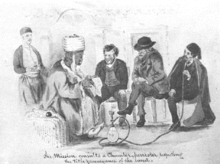Ottoman Empire
The Ottoman Empire (/ˈɒtəmən/; Ottoman Turkish: دولت عليه عثمانيه Devlet-i ʿAlīye-i ʿOsmānīye, literally "The Sublime Ottoman State"; Modern Turkish: Osmanlı İmparatorluğu or Osmanlı Devleti; French: Empire ottoman)[note 5][13] was a state and caliphate that controlled much of Southeastern Europe, Western Asia, and Northern Africa between the 14th and early 20th centuries. It was founded at the end of the 13th century in northwestern Anatolia in the town of Söğüt (modern-day Bilecik Province) by the Turkoman[14][15] tribal leader Osman I.[16] Although initially the dynasty was of Turkic origin, it was Persianised in terms of language, culture, literature and habits.[17][18][19][20] After 1354, the Ottomans crossed into Europe and with the conquest of the Balkans, the Ottoman beylik was transformed into a transcontinental empire. The Ottomans ended the Byzantine Empire with the 1453 conquest of Constantinople by Mehmed the Conqueror.[21]
The Sublime Ottoman State دولت عليه عثمانیه Devlet-i ʿAlīye-i ʿOsmānīye | |
|---|---|
| 1299–1922 | |
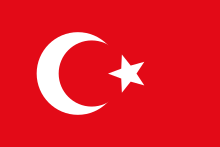  | |
Motto: دولت ابد مدت Devlet-i Ebed-müddet ("The Eternal State") | |
Anthem: various | |
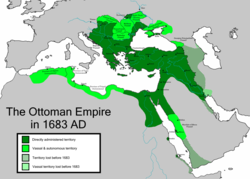 The Ottoman Empire at its greatest extent in Europe, under Sultan Mehmed IV | |
| Capital | |
| Common languages |
|
| Religion |
|
| Government | Absolute monarchy (1299–1876; 1878–1908; 1920–1922) and Caliphate (1517–1924[8]) Constitutional monarchy (1876–1878; 1908–1920) |
| Sultan | |
• c.1299–1323/4 (first) | Osman I |
• 1918–1922 (last) | Mehmed VI |
| Caliph | |
• 1517–1520 (first) | Selim I[9][note 2] |
• 1922–1924 (last) | Abdülmecid II |
| Grand Vizier | |
• 1320–1331 (first) | Alaeddin Pasha |
• 1920–1922 (last) | Ahmet Tevfik Pasha |
| Legislature | General Assembly |
• Unelected upper house | Chamber of Notables |
• Elected lower house | Chamber of Deputies |
| History | |
• Founded | c. 1299 |
| 1402–1413 | |
| 1453 | |
• 1st Constitutional | 1876–1878 |
• 2nd Constitutional | 1908–1920 |
• Raid on the Sublime Porte | 23 January 1913 |
• Sultanate abolished[note 3] | 1 November 1922 |
| 29 October 1923 | |
• Caliphate abolished | 3 March 1924 |
| Area | |
| 1451[10] | 690,000 km2 (270,000 sq mi) |
| 1521[10] | 3,400,000 km2 (1,300,000 sq mi) |
| 1683[10][11] | 5,200,000 km2 (2,000,000 sq mi) |
| Population | |
• 1912[12] | 24,000,000 |
| GDP (PPP) | 1913 estimate |
• Total | £220 million |
| Currency | Akçe, Para, Sultani, Kuruş, Lira |
During the 16th and 17th centuries, at the height of its power under the reign of Suleiman the Magnificent, the Ottoman Empire was a multinational, multilingual empire controlling most of Southeastern Europe, Central Europe, Western Asia, parts of Eastern Europe, the Caucasus, Northern Africa, and the Horn of Africa.[22] At the beginning of the 17th century, the empire contained 32 provinces and numerous vassal states. Some of these were later absorbed into the Ottoman Empire, while others were granted various types of autonomy over the course of centuries.[note 6]
With Constantinople (modern day Istanbul) as its capital and control of lands around the Mediterranean Basin, the Ottoman Empire was at the centre of interactions between the Eastern and Western worlds for six centuries. While the empire was once thought to have entered a period of decline following the death of Suleiman the Magnificent, this view is no longer supported by the majority of academic historians.[23] The empire continued to maintain a flexible and strong economy, society and military throughout the 17th and for much of the 18th century.[24] However, during a long period of peace from 1740 to 1768, the Ottoman military system fell behind that of their European rivals, the Habsburg and Russian empires.[25] The Ottomans consequently suffered severe military defeats in the late 18th and early 19th centuries, which prompted them to initiate a comprehensive process of reform and modernisation known as the Tanzimat. Thus, over the course of the 19th century, the Ottoman state became vastly more powerful and organised, despite suffering further territorial losses, especially in the Balkans, where a number of new states emerged.[26]
In the early 20th century, the empire allied with Germany, hoping to escape from the diplomatic isolation which had contributed to its recent territorial losses, and thus joined World War I on the side of the Central Powers.[27] While the Empire was able to largely hold its own during the conflict, it was struggling with internal dissent, especially with the Arab Revolt in its Arabian holdings. During this time, genocide was committed by the Ottoman government against the Armenians, Assyrians, and Greeks.[28]
The Empire's defeat and the occupation of part of its territory by the Allied Powers in the aftermath of World War I resulted in its partitioning and the loss of its Middle Eastern territories, which were divided between the United Kingdom and France. The successful Turkish War of Independence led by Mustafa Kemal Atatürk against the occupying Allies led to the emergence of the Republic of Turkey in the Anatolian heartland and the abolition of the Ottoman monarchy.[29]
Name
.jpg)
The word Ottoman is a historical anglicisation of the name of Osman I, the founder of the Empire and of the ruling House of Osman (also known as the Ottoman dynasty). Osman's name in turn was the Turkish form of the Arabic name ʿUthmān (عثمان). In Ottoman Turkish, the empire was referred to as Devlet-i ʿAlīye-yi ʿOsmānīye (دولت عليه عثمانیه),[30] (literally "The Supreme Ottoman State") or alternatively ʿOsmānlı Devleti (عثمانلى دولتى). In Modern Turkish, it is known as Osmanlı İmparatorluğu ("The Ottoman Empire") or Osmanlı Devleti ("The Ottoman State").
The Turkish word for "Ottoman" (Turkish: Osmanlı) originally referred to the tribal followers of Osman in the fourteenth century. The word subsequently came to be used to refer to the empire's military-administrative elite. In contrast, the term "Turk" (Türk) was used to refer to the Anatolian peasant and tribal population and was seen as a disparaging term when applied to urban, educated individuals.[31] In the early modern period, an educated, urban-dwelling Turkish-speaker who was not a member of the military-administrative class would often refer to himself neither as an Osmanlı nor as a Türk, but rather as a Rūmī (رومى), or "Roman", meaning an inhabitant of the territory of the former Byzantine Empire in the Balkans and Anatolia. The term Rūmī was also used to refer to Turkish-speakers by the other Muslim peoples of the empire and beyond.[32] As applied to Ottoman Turkish-speakers, this term began to fall out of use at the end of the seventeenth century, and instead the word increasingly became associated with the Greek population of the empire, a meaning that it still bears in Turkey today.[33]
In Western Europe, the names Ottoman Empire, Turkish Empire and Turkey were often used interchangeably, with Turkey being increasingly favoured both in formal and informal situations. This dichotomy was officially ended in 1920–23, when the newly established Ankara-based Turkish government chose Turkey as the sole official name. At present, most scholarly historians avoid the terms "Turkey", "Turks", and "Turkish" when referring to the Ottomans, due to the empire's multinational character.[34]
History
Rise (c. 1299–1453)
As the Seljuk Sultanate of Rum declined in the 13th century, Anatolia was divided into a patchwork of independent Turkish principalities known as the Anatolian Beyliks. One of these beyliks, in the region of Bithynia on the frontier of the Byzantine Empire, was led by the Turkish tribal leader Osman I (d. 1323/4), a figure of obscure origins from whom the name Ottoman is derived.[35] Osman's early followers consisted both of Turkish tribal groups and Byzantine renegades, with many but not all converts to Islam.[36] Osman extended the control of his principality by conquering Byzantine towns along the Sakarya River. A Byzantine defeat at the Battle of Bapheus in 1302 contributed to Osman's rise as well. It is not well understood how the early Ottomans came to dominate their neighbours, due to the lack of sources surviving from this period. The Gaza Thesis theory popular during the twentieth century credited their success to their rallying of religious warriors to fight for them in the name of Islam, but it is now highly criticised and no longer generally accepted by historians, and no consensus on the nature of the early Ottoman state's expansion has replaced it.[37]
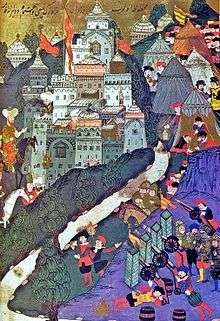
In the century after the death of Osman I, Ottoman rule began to extend over Anatolia and the Balkans. Osman's son, Orhan, captured the northwestern Anatolian city of Bursa in 1326, making it the new capital of the Ottoman state and supplanting Byzantine control in the region. The important port city of Thessaloniki was captured from the Venetians in 1387 and sacked. The Ottoman victory in Kosovo in 1389 effectively marked the end of Serbian power in the region, paving the way for Ottoman expansion into Europe.[38] The Battle of Nicopolis in 1396, widely regarded as the last large-scale crusade of the Middle Ages, failed to stop the advance of the victorious Ottoman Turks.[39]
Part of a series on the |
|---|
| History of the Ottoman Empire |
 |
| Timeline |
|
Rise (1299–1453)
|
|
Classical Age (1453–1566)
|
|
Transformation (1566–1703)
|
|
Old Regime (1703–1789)
|
|
Decline & Modernization (1789–1908)
|
|
Dissolution (1908–1922)
|
| Historiography (Ghaza, Decline) |
As the Turks expanded into the Balkans, the conquest of Constantinople became a crucial objective. The Ottomans had already wrested control of nearly all former Byzantine lands surrounding the city, but the strong defence of Constantinople's strategic position on the Bosphorus Strait made it difficult to conquer. In 1402, the Byzantines were temporarily relieved when the Turco-Mongol leader Timur, founder of the Timurid Empire, invaded Ottoman Anatolia from the east. In the Battle of Ankara in 1402, Timur defeated the Ottoman forces and took Sultan Bayezid I as a prisoner, throwing the empire into disorder. The ensuing civil war, also known as the Fetret Devri, lasted from 1402 to 1413 as Bayezid's sons fought over succession. It ended when Mehmed I emerged as the sultan and restored Ottoman power.[40]
The Balkan territories lost by the Ottomans after 1402, including Thessaloniki, Macedonia, and Kosovo, were later recovered by Murad II between the 1430s and 1450s. On 10 November 1444, Murad repelled the Crusade of Varna by defeating the Hungarian, Polish, and Wallachian armies under Władysław III of Poland (also King of Hungary) and John Hunyadi at the Battle of Varna, although Albanians under Skanderbeg continued to resist. Four years later, John Hunyadi prepared another army of Hungarian and Wallachian forces to attack the Turks, but was again defeated at the Second Battle of Kosovo in 1448.[41]
Expansion and peak (1453–1566)


.jpg)
The son of Murad II, Mehmed the Conqueror, reorganized both state and military, and on 29 May 1453 conquered Constantinople. Mehmed allowed the Orthodox Church to maintain its autonomy and land in exchange for accepting Ottoman authority.[43] Due to tension between the states of western Europe and the later Byzantine Empire, the majority of the Orthodox population accepted Ottoman rule as preferable to Venetian rule.[43] Albanian resistance was a major obstacle to Ottoman expansion on the Italian peninsula.[44]
In the 15th and 16th centuries, the Ottoman Empire entered a period of expansion. The Empire prospered under the rule of a line of committed and effective Sultans. It also flourished economically due to its control of the major overland trade routes between Europe and Asia.[45][note 7]
Sultan Selim I (1512–1520) dramatically expanded the Empire's eastern and southern frontiers by defeating Shah Ismail of Safavid Iran, in the Battle of Chaldiran.[46] Selim I established Ottoman rule in Egypt by defeating and annexing the Mamluk Sultanate of Egypt and created a naval presence on the Red Sea. After this Ottoman expansion, competition began between the Portuguese Empire and the Ottoman Empire to become the dominant power in the region.[47]
Suleiman the Magnificent (1520–1566) captured Belgrade in 1521, conquered the southern and central parts of the Kingdom of Hungary as part of the Ottoman–Hungarian Wars,[48][49] and, after his historic victory in the Battle of Mohács in 1526, he established Turkish rule in the territory of present-day Hungary (except the western part) and other Central European territories. He then laid siege to Vienna in 1529, but failed to take the city.[50] In 1532, he made another attack on Vienna, but was repulsed in the Siege of Güns.[51][52] Transylvania, Wallachia and, intermittently, Moldavia, became tributary principalities of the Ottoman Empire. In the east, the Ottoman Turks took Baghdad from the Persians in 1535, gaining control of Mesopotamia and naval access to the Persian Gulf. In 1555, the Caucasus became officially partitioned for the first time between the Safavids and the Ottomans, a status quo that would remain until the end of the Russo-Turkish War (1768–74). By this partitioning of the Caucasus as signed in the Peace of Amasya, Western Armenia, western Kurdistan, and Western Georgia (incl. western Samtskhe) fell into Ottoman hands,[53] while southern Dagestan, Eastern Armenia, Eastern Georgia, and Azerbaijan remained Persian.[54]
In 1539, a 60,000-strong Ottoman army besieged the Spanish garrison of Castelnuovo on the Adriatic coast; the successful siege cost the Ottomans 8,000 casualties,[55] but Venice agreed to terms in 1540, surrendering most of its empire in the Aegean and the Morea. France and the Ottoman Empire, united by mutual opposition to Habsburg rule, became strong allies. The French conquests of Nice (1543) and Corsica (1553) occurred as a joint venture between the forces of the French king Francis I and Suleiman, and were commanded by the Ottoman admirals Barbarossa Hayreddin Pasha and Turgut Reis.[56] A month before the siege of Nice, France supported the Ottomans with an artillery unit during the 1543 Ottoman conquest of Esztergom in northern Hungary. After further advances by the Turks, the Habsburg ruler Ferdinand officially recognized Ottoman ascendancy in Hungary in 1547. Suleiman I died of natural causes in his tent during the Siege of Szigetvár in 1566.
By the end of Suleiman's reign, the Empire spanned approximately 877,888 sq mi (2,273,720 km2), extending over three continents.[57] In addition, the Empire became a dominant naval force, controlling much of the Mediterranean Sea.[58] By this time, the Ottoman Empire was a major part of the European political sphere. The Ottomans became involved in multi-continental religious wars when Spain and Portugal were united under the Iberian Union, the Ottomans as holders of the Caliph title, meaning leader of all Muslims worldwide, and Iberians, as leaders of the Christian crusaders, were locked in a worldwide conflict, with zones of operations in the Mediterranean Sea[59] and Indian Ocean[60] where Iberians circumnavigated Africa to reach India, and on their way, wage wars upon the Ottomans and their local Muslim allies. Likewise, the Iberians passed through newly-Christianized Latin America and had sent expeditions that traversed the Pacific in order to Christianize the formerly Muslim Philippines and use it as a base to further attack the Muslims in the Far East.[61] In this case, the Ottomans sent armies to aid its easternmost vassal and territory, the Sultanate of Aceh in Southeast Asia.[62][63] During the 1600s the worldwide conflict between the Ottoman Caliphate and Iberian Union was a stalemate since both powers were at similar population, technology and economic levels. Nevertheless, the success of the Ottoman political and military establishment was compared to the Roman Empire, by the likes of Italian scholar Francesco Sansovino and the French political philosopher Jean Bodin.[64]
Stagnation and reform (1566–1827)
Revolts, reversals, and revivals (1566–1683)
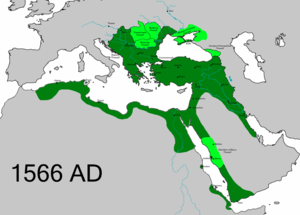
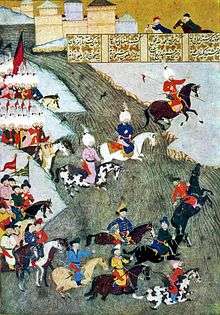
In the second half of the sixteenth century, the Ottoman Empire came under increasing strain from inflation and the rapidly rising costs of warfare that were impacting both Europe and the Middle East. These pressures led to a series of crises around the year 1600, placing great strain upon the Ottoman system of government.[65] The empire underwent a series of transformations of its political and military institutions in response to these challenges, enabling it to successfully adapt to the new conditions of the seventeenth century and remain powerful, both militarily and economically.[23][66] Historians of the mid-twentieth century once characterized this period as one of stagnation and decline, but this view is now rejected by the majority of academics.[23]
The discovery of new maritime trade routes by Western European states allowed them to avoid the Ottoman trade monopoly. The Portuguese discovery of the Cape of Good Hope in 1488 initiated a series of Ottoman-Portuguese naval wars in the Indian Ocean throughout the 16th century. Despite the growing European presence in the Indian Ocean, Ottoman trade with the east continued to flourish. Cairo, in particular, benefitted from the rise of Yemeni coffee as a popular consumer commodity. As coffeehouses appeared in cities and towns across the empire, Cairo developed into a major center for its trade, contributing to its continued prosperity throughout the seventeenth and much of the eighteenth century.[67]
Under Ivan IV (1533–1584), the Tsardom of Russia expanded into the Volga and Caspian region at the expense of the Tatar khanates. In 1571, the Crimean khan Devlet I Giray, commanded by the Ottomans, burned Moscow.[68] The next year, the invasion was repeated but repelled at the Battle of Molodi. The Ottoman Empire continued to invade Eastern Europe in a series of slave raids,[69] and remained a significant power in Eastern Europe until the end of the 17th century.[70]
The Ottomans decided to conquer Venetian Cyprus and on July 22, 1570, Nicosia was besieged; 50,000 Christians died, and 180,000 were enslaved.[71] On September 15, 1570, the Ottoman cavalry appeared before the last Venetian stronghold in Cyprus, Famagusta. The Venetian defenders would hold out for 11 months against a force that would come to number 200,000 men with 145 cannons; 163,000 cannonballs struck the walls of Famagusta before it fell to the Ottomans in August 1571. The Siege of Famagusta claimed 50,000 Ottoman casualties.[72] Meanwhile, the Holy league consisting of mostly Spanish and Venetian fleets won a victory over the Ottoman fleet at the Battle of Lepanto (1571), off southwestern Greece; Catholic forces killed over 30,000 Turks and destroyed 200 of their ships.[73] It was a startling, if mostly symbolic,[74] blow to the image of Ottoman invincibility, an image which the victory of the Knights of Malta against the Ottoman invaders in the 1565 Siege of Malta had recently set about eroding.[75] The battle was far more damaging to the Ottoman navy in sapping experienced manpower than the loss of ships, which were rapidly replaced.[76] The Ottoman navy recovered quickly, persuading Venice to sign a peace treaty in 1573, allowing the Ottomans to expand and consolidate their position in North Africa.[77]
By contrast, the Habsburg frontier had settled somewhat, a stalemate caused by a stiffening of the Habsburg defences .[78] The Long Turkish War against Habsburg Austria (1593–1606) created the need for greater numbers of Ottoman infantry equipped with firearms, resulting in a relaxation of recruitment policy. This contributed to problems of indiscipline and outright rebelliousness within the corps, which were never fully solved.[79] Irregular sharpshooters (Sekban) were also recruited, and on demobilization turned to brigandage in the Jelali revolts (1590–1610), which engendered widespread anarchy in Anatolia in the late 16th and early 17th centuries.[80] With the Empire's population reaching 30 million people by 1600, the shortage of land placed further pressure on the government.[81] In spite of these problems, the Ottoman state remained strong, and its army did not collapse or suffer crushing defeats. The only exceptions were campaigns against the Safavid dynasty of Persia, where many of the Ottoman eastern provinces were lost, some permanently. This 1603–1618 war eventually resulted in the Treaty of Nasuh Pasha, which ceded the entire Caucasus, except westernmost Georgia, back into Iranian Safavid possession.[82] The treaty ending the Cretan War (1645–1669) cost Venice much of Dalmatia, its Aegean island possessions, and Crete. (Losses from the war totaled 30,985 Venetian soldiers and 118,754 Turkish soldiers.)[83]
_-_Skoklosters_slott_-_82210.tif.jpg)
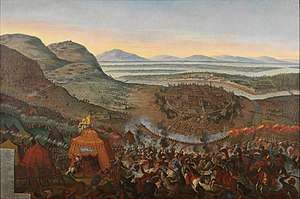
During his brief majority reign, Murad IV (1623–1640) reasserted central authority and recaptured Iraq (1639) from the Safavids.[84] The resulting Treaty of Zuhab of that same year decisively parted the Caucasus and adjacent regions between the two neighbouring empires as it had already been defined in the 1555 Peace of Amasya.[85][86] The Sultanate of women (1623–1656) was a period in which the mothers of young sultans exercised power on behalf of their sons. The most prominent women of this period were Kösem Sultan and her daughter-in-law Turhan Hatice, whose political rivalry culminated in Kösem's murder in 1651.[87] During the Köprülü Era (1656–1703), effective control of the Empire was exercised by a sequence of Grand Viziers from the Köprülü family. The Köprülü Vizierate saw renewed military success with authority restored in Transylvania, the conquest of Crete completed in 1669, and expansion into Polish southern Ukraine, with the strongholds of Khotyn and Kamianets-Podilskyi and the territory of Podolia ceding to Ottoman control in 1676.[88]
This period of renewed assertiveness came to a calamitous end in 1683 when Grand Vizier Kara Mustafa Pasha led a huge army to attempt a second Ottoman siege of Vienna in the Great Turkish War of 1683–1699. The final assault being fatally delayed, the Ottoman forces were swept away by allied Habsburg, German, and Polish forces spearheaded by the Polish king John III Sobieski at the Battle of Vienna. The alliance of the Holy League pressed home the advantage of the defeat at Vienna, culminating in the Treaty of Karlowitz (26 January 1699), which ended the Great Turkish War.[89] The Ottomans surrendered control of significant territories, many permanently.[90] Mustafa II (1695–1703) led the counterattack of 1695–96 against the Habsburgs in Hungary, but was undone at the disastrous defeat at Zenta (in modern Serbia), 11 September 1697.[91]
Military defeats
Aside from the loss of the Banat and the temporary loss of Belgrade (1717–39), the Ottoman border on the Danube and Sava remained stable during the eighteenth century. Russian expansion, however, presented a large and growing threat.[92] Accordingly, King Charles XII of Sweden was welcomed as an ally in the Ottoman Empire following his defeat by the Russians at the Battle of Poltava of 1709 in central Ukraine (part of the Great Northern War of 1700–1721).[92] Charles XII persuaded the Ottoman Sultan Ahmed III to declare war on Russia, which resulted in an Ottoman victory in the Pruth River Campaign of 1710–1711, in Moldavia.[93]
After the Austro-Turkish War of 1716–1718, the Treaty of Passarowitz confirmed the loss of the Banat, Serbia and "Little Walachia" (Oltenia) to Austria. The Treaty also revealed that the Ottoman Empire was on the defensive and unlikely to present any further aggression in Europe.[94] The Austro-Russian–Turkish War (1735–1739), which was ended by the Treaty of Belgrade in 1739, resulted in the recovery of Serbia and Oltenia, but the Empire lost the port of Azov, north of the Crimean Peninsula, to the Russians. After this treaty the Ottoman Empire was able to enjoy a generation of peace, as Austria and Russia were forced to deal with the rise of Prussia.[95]
Educational and technological reforms came about, including the establishment of higher education institutions such as the Istanbul Technical University.[96] In 1734 an artillery school was established to impart Western-style artillery methods, but the Islamic clergy successfully objected under the grounds of theodicy.[97] In 1754 the artillery school was reopened on a semi-secret basis.[97] In 1726, Ibrahim Muteferrika convinced the Grand Vizier Nevşehirli Damat İbrahim Pasha, the Grand Mufti, and the clergy on the efficiency of the printing press, and Muteferrika was later granted by Sultan Ahmed III permission to publish non-religious books (despite opposition from some calligraphers and religious leaders).[98] Muteferrika's press published its first book in 1729 and, by 1743, issued 17 works in 23 volumes, each having between 500 and 1,000 copies.[98][99]

In Ottoman North Africa, Spain conquered Oran from the Ottoman Empire (1732). The bey received an Ottoman army from Algiers, but it failed to recapture Oran; the siege caused the deaths of 1,500 Spaniards, and even more Algerians. The Spanish also massacred many Muslim soldiers.[100] In 1792, Spain abandoned Oran, selling it to the Ottoman Empire.
In 1768 Russian-backed Ukrainian Haidamakas, pursuing Polish confederates, entered Balta, an Ottoman-controlled town on the border of Bessarabia in Ukraine, massacred its citizens, and burned the town to the ground. This action provoked the Ottoman Empire into the Russo-Turkish War of 1768–1774. The Treaty of Küçük Kaynarca of 1774 ended the war and provided freedom to worship for the Christian citizens of the Ottoman-controlled provinces of Wallachia and Moldavia.[101] By the late 18th century, after a number of defeats in the wars with Russia, some people in the Ottoman Empire began to conclude that the reforms of Peter the Great had given the Russians an edge, and the Ottomans would have to keep up with Western technology in order to avoid further defeats.[97]
Selim III (1789–1807) made the first major attempts to modernize the army, but his reforms were hampered by the religious leadership and the Janissary corps. Jealous of their privileges and firmly opposed to change, the Janissary revolted. Selim's efforts cost him his throne and his life, but were resolved in spectacular and bloody fashion by his successor, the dynamic Mahmud II, who eliminated the Janissary corps in 1826.
.jpg)
The Serbian revolution (1804–1815) marked the beginning of an era of national awakening in the Balkans during the Eastern Question. In 1811, the fundamentalist Wahhabis of Arabia, led by the al-Saud family, revolted against the Ottomans. Unable to defeat the Wahhabi rebels, the Sublime Porte had Mohammad Ali the Great, the vali (governor) of Egypt tasked with retaking Arabia, which ended with the destruction of the Emirate of Diriyah in 1818. The Suzerainty of Serbia as a hereditary monarchy under its own dynasty was acknowledged de jure in 1830.[102][103] In 1821, the Greeks declared war on the Sultan. A rebellion that originated in Moldavia as a diversion was followed by the main revolution in the Peloponnese, which, along with the northern part of the Gulf of Corinth, became the first parts of the Ottoman Empire to achieve independence (in 1829). In 1830, the French invaded Ottoman Algeria, which was lost to the empire; between 500,000 and 1,000,000 Algerians were killed,[104][105] while French forces suffered only 3,336 killed in action.[106] In 1831, Mohammad Ali revolted with the aim of making himself sultan and founding a new dynasty, and his French-trained army under his son Ibrahim Pasha defeated the Ottoman Army as it marched on Constantinople, coming within 320 km (200 mi) of the capital.[107] In desperation, the Sultan Mahmud II appealed to the empire's traditional archenemy Russia for help, asking Emperor Nicholas I to send an expeditionary force to save him.[108] In return for signing the Treaty of Hünkâr İskelesi, the Russians sent the expeditionary force, which deterred Ibrahim from taking Constantinople.[108] Under the terms of Peace of Kutahia, signed on 5 May 1833 Mohammad Ali agreed to abandon his claim to the throne, in exchange for which he was made the vali of the vilayets (provinces) of Crete, Aleppo, Tripoli, Damascus and Sidon (the latter four comprising modern Syria and Lebanon), and given the right to collect taxes in Adana.[108] Had it not been for the Russian intervention, it is almost certain Mahmud II would have been overthrown and Mohammad Ali would have become the new sultan, marking the beginning of a recurring pattern where the Sublime Porte needed the help of outsiders to save itself.[109]
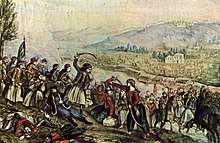
In 1839, the Sublime Porte attempted to take back what it lost to the de facto independent vilayet of Egypt, and suffered a crushing defeat, leading to the Oriental Crisis as Mohammad Ali was very close to France, and the prospect of him as Sultan was widely viewed as putting the entire empire into the French sphere of influence.[108] As the Sublime Porte had proved itself incapable of defeating the Egyptians, Britain, and Austria intervened to defeat Egypt.[108] By the mid-19th century, the Ottoman Empire was called the "sick man" by Europeans. The suzerain states – the Principality of Serbia, Wallachia and Moldavia – moved towards de jure independence during the 1860s and 1870s.
Decline and modernization (1828–1908)
During the Tanzimat period (1839–1876), the government's series of constitutional reforms led to a fairly modern conscripted army, banking system reforms, the decriminalization of homosexuality, the replacement of religious law with secular law[110] and guilds with modern factories. The Ottoman Ministry of Post was established in Istanbul in 1840. American inventor Samuel Morse received an Ottoman patent for the telegraph in 1847, which was issued by Sultan Abdülmecid who personally tested the new invention.[111] The reformist period peaked with the Constitution, called the Kanûn-u Esâsî. The empire's First Constitutional era was short-lived. The parliament survived for only two years before the sultan suspended it.

The Christian population of the empire, owing to their higher educational levels, started to pull ahead of the Muslim majority, leading to much resentment on the part of the latter.[112] In 1861, there were 571 primary and 94 secondary schools for Ottoman Christians with 140,000 pupils in total, a figure that vastly exceeded the number of Muslim children in school at the same time, who were further hindered by the amount of time spent learning Arabic and Islamic theology.[112] Author Norman Stone further suggests that the Arabic alphabet, which Turkish was written in until 1928, was very ill-suited to reflect the sounds of the Turkish language (which is a Turkic as opposed to Semitic language), which imposed a further difficulty on Turkish children.[112] In turn, the higher educational levels of the Christians allowed them to play a larger role in the economy, with the rise in prominence of groups such as the Sursock family indicative of this shift in influence.[113][112] In 1911, of the 654 wholesale companies in Istanbul, 528 were owned by ethnic Greeks.[112] In many cases, Christians and also Jews were able to gain protection from European consuls and citizenship, meaning they were protected from Ottoman law and not subject to the same economic regulations as their Muslim counterparts.[114]
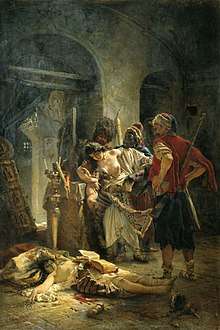
The Crimean War (1853–1856) was part of a long-running contest between the major European powers for influence over territories of the declining Ottoman Empire. The financial burden of the war led the Ottoman state to issue foreign loans amounting to 5 million pounds sterling on 4 August 1854.[118][119] The war caused an exodus of the Crimean Tatars, about 200,000 of whom moved to the Ottoman Empire in continuing waves of emigration.[120] Toward the end of the Caucasian Wars, 90% of the Circassians were ethnically cleansed[121] and exiled from their homelands in the Caucasus and fled to the Ottoman Empire,[122] resulting in the settlement of 500,000 to 700,000 Circassians in Turkey.[123][124][125] Some Circassian organisations give much higher numbers, totaling 1–1.5 million deported or killed. Crimean Tatar refugees in the late 19th century played an especially notable role in seeking to modernize Ottoman education and in first promoting both Pan-Turkism and a sense of Turkish nationalism.[126]
In this period, the Ottoman Empire spent only small amounts of public funds on education; for example in 1860–61 only 0.2 percent of the total budget was invested in education.[127] As the Ottoman state attempted to modernize its infrastructure and army in response to threats from the outside, it also opened itself up to a different kind of threat: that of creditors. Indeed, as the historian Eugene Rogan has written, "the single greatest threat to the independence of the Middle East" in the nineteenth century "was not the armies of Europe but its banks".[128] The Ottoman state, which had begun taking on debt with the Crimean War, was forced to declare bankruptcy in 1875.[129] By 1881, the Ottoman Empire agreed to have its debt controlled by an institution known as the Ottoman Public Debt Administration, a council of European men with presidency alternating between France and Britain. The body controlled swaths of the Ottoman economy, and used its position to ensure that European capital continued to penetrate the empire, often to the detriment of local Ottoman interests.[129]
The Ottoman bashi-bazouks brutally suppressed the Bulgarian uprising of 1876, massacring up to 100,000 people in the process.[130] The Russo-Turkish War (1877–78) ended with a decisive victory for Russia. As a result, Ottoman holdings in Europe declined sharply: Bulgaria was established as an independent principality inside the Ottoman Empire; Romania achieved full independence; and Serbia and Montenegro finally gained complete independence, but with smaller territories. In 1878, Austria-Hungary unilaterally occupied the Ottoman provinces of Bosnia-Herzegovina and Novi Pazar.
British Prime Minister Benjamin Disraeli advocated for restoring the Ottoman territories on the Balkan Peninsula during the Congress of Berlin, and in return, Britain assumed the administration of Cyprus in 1878.[131] Britain later sent troops to Egypt in 1882 to put down the Urabi Revolt – Sultan Abdul Hamid II was too paranoid to mobilize his own army, fearing this would result in a coup d'état – effectively gaining control in both territories. Abdul Hamid II, popularly known as "Abdul Hamid the Damned" on account of his cruelty and paranoia, was so fearful of the threat of a coup that he did not allow his army to conduct war games, lest this serve as the cover for a coup, but he did see the need for military mobilization. In 1883, a German military mission under General Baron Colmar von der Goltz arrived to train the Ottoman Army, leading to the so-called "Goltz generation" of German-trained officers who were to play a notable role in the politics of the last years of the empire.[132]
From 1894 to 1896, between 100,000 and 300,000 Armenians living throughout the empire were killed in what became known as the Hamidian massacres.[133]
In 1897 the population was 19 million, of whom 14 million (74%) were Muslim. An additional 20 million lived in provinces which remained under the sultan's nominal suzerainty but were entirely outside his actual power. One by one the Porte lost nominal authority. They included Egypt, Tunisia, Bulgaria, Cyprus, Bosnia-Herzegovina, and Lebanon.[134]
As the Ottoman Empire gradually shrank in size, some 7–9 million Muslims from its former territories in the Caucasus, Crimea, Balkans, and the Mediterranean islands migrated to Anatolia and Eastern Thrace.[135] After the Empire lost the First Balkan War (1912–13), it lost all its Balkan territories except East Thrace (European Turkey). This resulted in around 400,000 Muslims fleeing with the retreating Ottoman armies (with many dying from cholera brought by the soldiers), and with some 400,000 non-Muslims fleeing territory still under Ottoman rule.[136] Justin McCarthy estimates that during the period 1821 to 1922, 5.5 million Muslims died in southeastern Europe, with the expulsion of 5 million.[137][138][139]
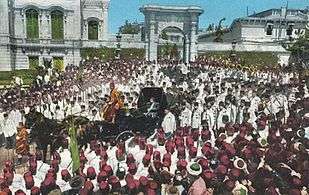 Sultan Abdul Hamid II going to the Friday Prayer (Friday Procession)
Sultan Abdul Hamid II going to the Friday Prayer (Friday Procession)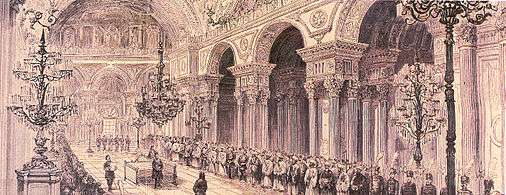 Opening ceremony of the First Ottoman Parliament at the Dolmabahçe Palace in 1876. The First Constitutional Era lasted for only two years until 1878. The Ottoman Constitution and Parliament were restored 30 years later with the Young Turk Revolution in 1908.
Opening ceremony of the First Ottoman Parliament at the Dolmabahçe Palace in 1876. The First Constitutional Era lasted for only two years until 1878. The Ottoman Constitution and Parliament were restored 30 years later with the Young Turk Revolution in 1908..jpg) Ottoman troops storming Fort Shefketil during the Crimean War of 1853–1856
Ottoman troops storming Fort Shefketil during the Crimean War of 1853–1856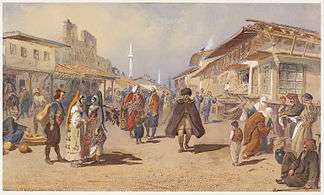 Belgrade, c. 1865. In 1867, Britain and France forced the Ottoman military to retreat from northern Serbia, securing its de facto independence (formalized after the Russo-Turkish War of 1877–78 and the Congress of Berlin in 1878.)
Belgrade, c. 1865. In 1867, Britain and France forced the Ottoman military to retreat from northern Serbia, securing its de facto independence (formalized after the Russo-Turkish War of 1877–78 and the Congress of Berlin in 1878.)
Defeat and dissolution (1908–1922)
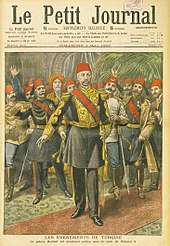
Young Turk movement
The defeat and dissolution of the Ottoman Empire (1908–1922) began with the Second Constitutional Era, a moment of hope and promise established with the Young Turk Revolution. It restored the Ottoman constitution of 1876 and brought in multi-party politics with a two-stage electoral system (electoral law) under the Ottoman parliament. The constitution offered hope by freeing the empire's citizens to modernize the state's institutions, rejuvenate its strength, and enable it to hold its own against outside powers. Its guarantee of liberties promised to dissolve inter-communal tensions and transform the empire into a more harmonious place.[140] Instead, this period became the story of the twilight struggle of the Empire.

Members of Young Turks movement who had once gone underground now established their parties.[141] Among them "Committee of Union and Progress", and "Freedom and Accord Party" were major parties. On the other end of the spectrum were ethnic parties, which included Poale Zion, Al-Fatat, and Armenian national movement organized under Armenian Revolutionary Federation. Profiting from the civil strife, Austria-Hungary officially annexed Bosnia and Herzegovina in 1908. The last of the Ottoman censuses was performed in 1914. Despite military reforms which reconstituted the Ottoman Modern Army, the Empire lost its North African territories and the Dodecanese in the Italo-Turkish War (1911) and almost all of its European territories in the Balkan Wars (1912–1913). The Empire faced continuous unrest in the years leading up to World War I, including the Ottoman countercoup of 1909, the 31 March Incident and two further coups in 1912 and 1913.
World War I
The war began with the Ottoman surprise attack on the Russian Black Sea coast on 29 October 1914. Following the attack, Russia and its allies, France and Britain declared war on the Ottomans. There were several important Ottoman victories in the early years of the war, such as the Battle of Gallipoli and the Siege of Kut.
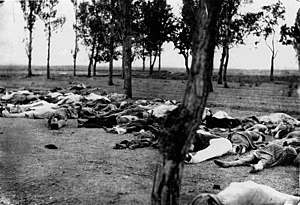
Armenian genocide
In 1915 the Ottoman government started the extermination of its ethnic Armenian population, resulting in the death of up to 1.5 million Armenians in the Armenian Genocide.[142] The genocide was carried out during and after World War I and implemented in two phases: the wholesale killing of the able-bodied male population through massacre and subjection of army conscripts to forced labor, followed by the deportation of women, children, the elderly and infirm on death marches leading to the Syrian desert. Driven forward by military escorts, the deportees were deprived of food and water and subjected to periodic robbery, rape, and systematic massacre.[143][144] Large-scale massacres were also committed against the Empire's Greek and Assyrian minorities as part of the same campaign of ethnic cleansing.[145]
Arab Revolt
The Arab Revolt began in 1916 with British support. It turned the tide against the Ottomans on the Middle Eastern front, where they seemed to have the upper hand during the first two years of the war. On the basis of the McMahon–Hussein Correspondence, an agreement between the British government and Hussein bin Ali, Sharif of Mecca, the revolt was officially initiated at Mecca on June 10, 1916.[note 8] The Arab nationalist goal was to create a single unified and independent Arab state stretching from Aleppo in Syria to Aden in Yemen, which the British had promised to recognize.
The Sharifian Army led by Hussein and the Hashemites, with military backing from the British Egyptian Expeditionary Force, successfully fought and expelled the Ottoman military presence from much of the Hejaz and Transjordan. The rebellion eventually took Damascus and set up a short-lived monarchy led by Faisal, a son of Hussein.
Following the Sykes-Picot Agreement, the Middle East was later partitioned by the British and French into mandate territories. There was no unified Arab state, much to the anger of Arab nationalists.
Treaty of Sèvres and Turkish War of Independence
Defeated on every front, the Ottoman Empire signed the Armistice of Mudros on 30 October 1918.

The partition of the Ottoman Empire was finalized under the terms of the Treaty of Sèvres. This treaty, as designed in the conference of London, allowed the Sultan to retain his position and title. The status of Anatolia was problematic given the Allied occupation of Constantinople and İzmir. There arose a nationalist opposition in the Turkish national movement. It won the Turkish War of Independence (1919–23) under the leadership of Mustafa Kemal (later given the surname "Atatürk"). The sultanate was abolished on 1 November 1922, and the last sultan, Mehmed VI (reigned 1918–22), left the country on 17 November 1922. The Republic of Turkey was established in its place on October 29, 1923, in the new capital city of Ankara. The caliphate was abolished on 3 March 1924.[147]
Historiographical debate on the Ottoman state
Several historians such as British historian Edward Gibbon and the Greek historian Dimitri Kitzikis have argued that after the fall of Constantinople, the Ottoman state took over the machinery of the Byzantine (Roman) state and that in essence, the Ottoman Empire was a continuation of the Eastern Roman Empire under a thin Turkish Islamic guise.[148] Kitzikis called the Ottoman state "a Greek-Turkish condominium".[149] The American historian Speros Vryonis wrote that the Ottoman state was centered on "a Byzantine-Balkan base with a veneer of the Turkish language and the Islamic religion".[150] Other historians have followed the lead of the Austrian historian Paul Wittek who emphasized the Islamic character of the Ottoman state, seeing the Ottoman state as a "Jihad state" dedicated to expanding the world of Islam.[150] Many historians led in 1937 by the Turkish historian M. Fuat Koprulu championed the Ghazi thesis that saw the Ottoman state as a continuation of the way of life of the nomadic Turkic tribes who had come from East Asia to Anatolia via Central Asia and the Middle East on a much larger scale. They argued that the most important cultural influences on the Ottoman state came from Persia.[151] More recently, the American historian Heath Lowry called the Ottoman state a "predatory confederacy" led in equal parts by Turks and Greeks converted to Islam.[152][153]
The British historian Norman Stone suggested many continuities between the Eastern Roman and Ottoman empires such as the zeugarion tax of Byzantium becoming the Ottoman Resm-i çift tax, the pronoia land-holding system that linked the amount of land one owned with one's ability to raise cavalry becoming the Ottoman timar system, and the Ottoman measurement for land the dönüm was the same as the Byzantine stremma. Stone also pointed out that despite the fact that Sunni Islam was the state religion, the Eastern Orthodox Church was supported and controlled by the Ottoman state, and in return to accepting that control became the largest land-holder in the Ottoman Empire. Despite the similarities, Stone argued that a crucial difference was that the land grants under the timar system were not hereditary at first. Even after land grants under the timar system became inheritable, land ownings in the Ottoman Empire remained highly insecure, and the sultan could and did revoke land grants whenever he wished. Stone argued this insecurity in land tenure strongly discouraged Timariots from seeking long-term development of their land, and instead led the timariots to adopt a strategy of short term exploitation, which ultimately had deleterious effects on the Ottoman economy.[154]
Most of the Ottoman Sultans adhered to Sufism and followed Sufi orders, and believed Sufism is the correct way to reach God.[155] Because the matters of jurisprudence and shariah were state matters, the state sponsored Sufi religious dominance came into play. Non-Sufi Muslims and Arabs were neglected and not given any position in the Hejaz.[156]
Government

Before the reforms of the 19th and 20th centuries, the state organisation of the Ottoman Empire was a system with two main dimensions, the military administration, and the civil administration. The Sultan was the highest position in the system. The civil system was based on local administrative units based on the region's characteristics. The state had control over the clergy. Certain pre-Islamic Turkish traditions that had survived the adoption of administrative and legal practices from Islamic Iran remained important in Ottoman administrative circles.[157] According to Ottoman understanding, the state's primary responsibility was to defend and extend the land of the Muslims and to ensure security and harmony within its borders in the overarching context of orthodox Islamic practice and dynastic sovereignty.[158]
The Ottoman Empire, or as a dynastic institution, the House of Osman, was unprecedented and unequaled in the Islamic world for its size and duration.[159] In Europe, only the House of Habsburg had a similarly unbroken line of sovereigns (kings/emperors) from the same family who ruled for so long, and during the same period, between the late 13th and early 20th centuries. The Ottoman dynasty was Turkish in origin. On eleven occasions, the sultan was deposed (replaced by another sultan of the Ottoman dynasty, who were either the former sultan's brother, son, or nephew) because he was perceived by his enemies as a threat to the state. There were only two attempts in Ottoman history to unseat the ruling Ottoman dynasty, both failures, which suggests a political system that for an extended period was able to manage its revolutions without unnecessary instability.[158] As such, the last Ottoman sultan Mehmed VI (r. 1918–1922) was a direct patrilineal (male-line) descendant of the first Ottoman sultan Osman I (d. 1323/4), which was unparallelled in both Europe (e.g., the male line of the House of Habsburg became extinct in 1740) and in the Islamic world. The primary purpose of the Imperial Harem was to ensure the birth of male heirs to the Ottoman throne and secure the continuation of the direct patrilineal (male-line) descendance of the Ottoman sultans.
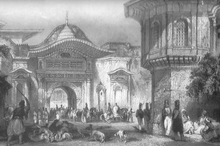
The highest position in Islam, caliphate, was claimed by the sultans starting with Murad I,[9] which was established as the Ottoman Caliphate. The Ottoman sultan, pâdişâh or "lord of kings", served as the Empire's sole regent and was considered to be the embodiment of its government, though he did not always exercise complete control. The Imperial Harem was one of the most important powers of the Ottoman court. It was ruled by the Valide Sultan. On occasion, the Valide Sultan would become involved in state politics. For a time, the women of the Harem effectively controlled the state in what was termed the "Sultanate of Women". New sultans were always chosen from the sons of the previous sultan. The strong educational system of the palace school was geared towards eliminating the unfit potential heirs and establishing support among the ruling elite for a successor. The palace schools, which would also educate the future administrators of the state, were not a single track. First, the Madrasa (Medrese) was designated for the Muslims, and educated scholars and state officials according to Islamic tradition. The financial burden of the Medrese was supported by vakifs, allowing children of poor families to move to higher social levels and income.[160] The second track was a free boarding school for the Christians, the Enderûn,[161] which recruited 3,000 students annually from Christian boys between eight and twenty years old from one in forty families among the communities settled in Rumelia or the Balkans, a process known as Devshirme (Devşirme).[162]
Though the sultan was the supreme monarch, the sultan's political and executive authority was delegated. The politics of the state had a number of advisors and ministers gathered around a council known as Divan. The Divan, in the years when the Ottoman state was still a Beylik, was composed of the elders of the tribe. Its composition was later modified to include military officers and local elites (such as religious and political advisors). Later still, beginning in 1320, a Grand Vizier was appointed to assume certain of the sultan's responsibilities. The Grand Vizier had considerable independence from the sultan with almost unlimited powers of appointment, dismissal, and supervision. Beginning with the late 16th century, sultans withdrew from politics and the Grand Vizier became the de facto head of state.[163]
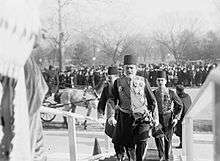
Throughout Ottoman history, there were many instances in which local governors acted independently, and even in opposition to the ruler. After the Young Turk Revolution of 1908, the Ottoman state became a constitutional monarchy. The sultan no longer had executive powers. A parliament was formed, with representatives chosen from the provinces. The representatives formed the Imperial Government of the Ottoman Empire.
This eclectic administration was apparent even in the diplomatic correspondence of the Empire, which was initially undertaken in the Greek language to the west.[164]
The Tughra were calligraphic monograms, or signatures, of the Ottoman Sultans, of which there were 35. Carved on the Sultan's seal, they bore the names of the Sultan and his father. The statement and prayer, "ever victorious", was also present in most. The earliest belonged to Orhan Gazi. The ornately stylized Tughra spawned a branch of Ottoman-Turkish calligraphy.
Law
The Ottoman legal system accepted the religious law over its subjects. At the same time the Qanun (or Kanun), a secular legal system, co-existed with religious law or Sharia.[165] The Ottoman Empire was always organized around a system of local jurisprudence. Legal administration in the Ottoman Empire was part of a larger scheme of balancing central and local authority.[166] Ottoman power revolved crucially around the administration of the rights to land, which gave a space for the local authority to develop the needs of the local millet.[166] The jurisdictional complexity of the Ottoman Empire was aimed to permit the integration of culturally and religiously different groups.[166] The Ottoman system had three court systems: one for Muslims, one for non-Muslims, involving appointed Jews and Christians ruling over their respective religious communities, and the "trade court". The entire system was regulated from above by means of the administrative Qanun, i.e., laws, a system based upon the Turkic Yassa and Töre, which were developed in the pre-Islamic era.
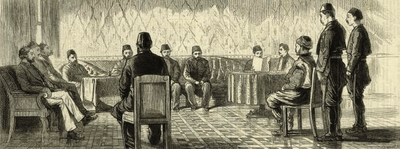
These court categories were not, however, wholly exclusive; for instance, the Islamic courts, which were the Empire's primary courts, could also be used to settle a trade conflict or disputes between litigants of differing religions, and Jews and Christians often went to them to obtain a more forceful ruling on an issue. The Ottoman state tended not to interfere with non-Muslim religious law systems, despite legally having a voice to do so through local governors. The Islamic Sharia law system had been developed from a combination of the Qur'an; the Hadīth, or words of the prophet Muhammad; ijmā', or consensus of the members of the Muslim community; qiyas, a system of analogical reasoning from earlier precedents; and local customs. Both systems were taught at the Empire's law schools, which were in Istanbul and Bursa.
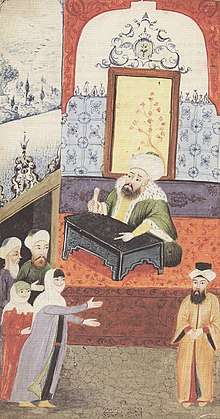
The Ottoman Islamic legal system was set up differently from traditional European courts. Presiding over Islamic courts would be a Qadi, or judge. Since the closing of the ijtihad, or Gate of Interpretation, Qadis throughout the Ottoman Empire focused less on legal precedent, and more with local customs and traditions in the areas that they administered.[166] However, the Ottoman court system lacked an appellate structure, leading to jurisdictional case strategies where plaintiffs could take their disputes from one court system to another until they achieved a ruling that was in their favor.
In the late 19th century, the Ottoman legal system saw substantial reform. This process of legal modernization began with the Edict of Gülhane of 1839.[167] These reforms included the "fair and public trial[s] of all accused regardless of religion", the creation of a system of "separate competences, religious and civil", and the validation of testimony on non-Muslims.[168] Specific land codes (1858), civil codes (1869–1876), and a code of civil procedure also were enacted.[168]
These reforms were based heavily on French models, as indicated by the adoption of a three-tiered court system. Referred to as Nizamiye, this system was extended to the local magistrate level with the final promulgation of the Mecelle, a civil code that regulated marriage, divorce, alimony, will, and other matters of personal status.[168] In an attempt to clarify the division of judicial competences, an administrative council laid down that religious matters were to be handled by religious courts, and statute matters were to be handled by the Nizamiye courts.[168]
Military
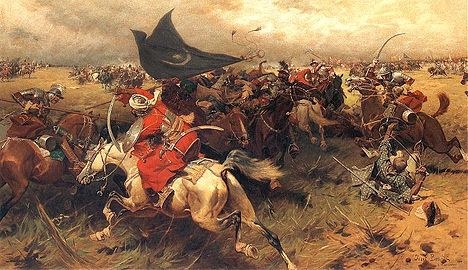
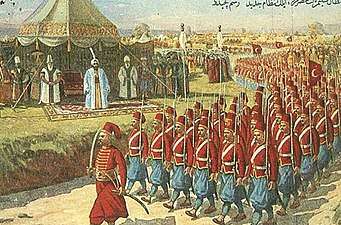
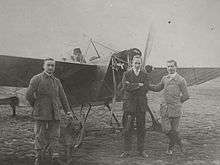
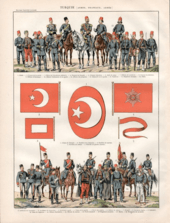
The first military unit of the Ottoman State was an army that was organized by Osman I from the tribesmen inhabiting the hills of western Anatolia in the late 13th century. The military system became an intricate organization with the advance of the Empire. The Ottoman military was a complex system of recruiting and fief-holding. The main corps of the Ottoman Army included Janissary, Sipahi, Akıncı and Mehterân. The Ottoman army was once among the most advanced fighting forces in the world, being one of the first to use muskets and cannons. The Ottoman Turks began using falconets, which were short but wide cannons, during the Siege of Constantinople. The Ottoman cavalry depended on high speed and mobility rather than heavy armour, using bows and short swords on fast Turkoman and Arabian horses (progenitors of the Thoroughbred racing horse),[169][170] and often applied tactics similar to those of the Mongol Empire, such as pretending to retreat while surrounding the enemy forces inside a crescent-shaped formation and then making the real attack. The Ottoman army continued to be an effective fighting force throughout the seventeenth and early eighteenth centuries,[171] falling behind the empire's European rivals only during a long period of peace from 1740–1768.[25]
The modernization of the Ottoman Empire in the 19th century started with the military. In 1826 Sultan Mahmud II abolished the Janissary corps and established the modern Ottoman army. He named them as the Nizam-ı Cedid (New Order). The Ottoman army was also the first institution to hire foreign experts and send its officers for training in western European countries. Consequently, the Young Turks movement began when these relatively young and newly trained men returned with their education.
The Ottoman Navy vastly contributed to the expansion of the Empire's territories on the European continent. It initiated the conquest of North Africa, with the addition of Algeria and Egypt to the Ottoman Empire in 1517. Starting with the loss of Greece in 1821 and Algeria in 1830, Ottoman naval power and control over the Empire's distant overseas territories began to decline. Sultan Abdülaziz (reigned 1861–1876) attempted to reestablish a strong Ottoman navy, building the largest fleet after those of Britain and France. The shipyard at Barrow, England, built its first submarine in 1886 for the Ottoman Empire.[172]
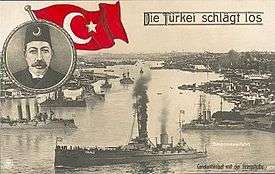
However, the collapsing Ottoman economy could not sustain the fleet's strength for long. Sultan Abdülhamid II distrusted the admirals who sided with the reformist Midhat Pasha and claimed that the large and expensive fleet was of no use against the Russians during the Russo-Turkish War. He locked most of the fleet inside the Golden Horn, where the ships decayed for the next 30 years. Following the Young Turk Revolution in 1908, the Committee of Union and Progress sought to develop a strong Ottoman naval force. The Ottoman Navy Foundation was established in 1910 to buy new ships through public donations.
The establishment of Ottoman military aviation dates back to between June 1909 and July 1911.[173][174] The Ottoman Empire started preparing its first pilots and planes, and with the founding of the Aviation School (Tayyare Mektebi) in Yeşilköy on 3 July 1912, the Empire began to tutor its own flight officers. The founding of the Aviation School quickened advancement in the military aviation program, increased the number of enlisted persons within it, and gave the new pilots an active role in the Ottoman Army and Navy. In May 1913, the world's first specialized Reconnaissance Training Program was started by the Aviation School, and the first separate reconnaissance division was established. In June 1914 a new military academy, the Naval Aviation School (Bahriye Tayyare Mektebi) was founded. With the outbreak of World War I, the modernization process stopped abruptly. The Ottoman aviation squadrons fought on many fronts during World War I, from Galicia in the west to the Caucasus in the east and Yemen in the south.
Administrative divisions
.png)
The Ottoman Empire was first subdivided into provinces, in the sense of fixed territorial units with governors appointed by the sultan, in the late 14th century.[175]
The Eyalet (also Pashalik or Beylerbeylik) was the territory of office of a Beylerbey (“lord of lords” or governor), and was further subdivided in Sanjaks.[176]
The Vilayets were introduced with the promulgation of the "Vilayet Law" (Teskil-i Vilayet Nizamnamesi)[177] in 1864, as part of the Tanzimat reforms.[178] Unlike the previous eyalet system, the 1864 law established a hierarchy of administrative units: the vilayet, liva/sanjak, kaza and village council, to which the 1871 Vilayet Law added the nabiye.[179]
Economy
Ottoman government deliberately pursued a policy for the development of Bursa, Edirne, and Istanbul, successive Ottoman capitals, into major commercial and industrial centres, considering that merchants and artisans were indispensable in creating a new metropolis.[180] To this end, Mehmed and his successor Bayezid, also encouraged and welcomed migration of the Jews from different parts of Europe, who were settled in Istanbul and other port cities like Salonica. In many places in Europe, Jews were suffering persecution at the hands of their Christian counterparts, such as in Spain, after the conclusion of Reconquista. The tolerance displayed by the Turks was welcomed by the immigrants.
.jpg)
The Ottoman economic mind was closely related to the basic concepts of state and society in the Middle East in which the ultimate goal of a state was consolidation and extension of the ruler's power, and the way to reach it was to get rich resources of revenues by making the productive classes prosperous.[181] The ultimate aim was to increase the state revenues without damaging the prosperity of subjects to prevent the emergence of social disorder and to keep the traditional organization of the society intact. The Ottoman economy greatly expanded during the early modern period, with particularly high growth rates during the first half of the eighteenth century. The empire's annual income quadrupled between 1523 and 1748, adjusted for inflation.[182]
The organization of the treasury and chancery were developed under the Ottoman Empire more than any other Islamic government and, until the 17th century, they were the leading organization among all their contemporaries.[163] This organization developed a scribal bureaucracy (known as "men of the pen") as a distinct group, partly highly trained ulama, which developed into a professional body.[163] The effectiveness of this professional financial body stands behind the success of many great Ottoman statesmen.[183]
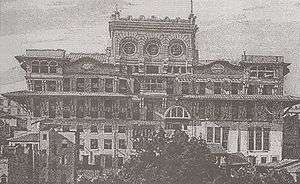
Modern Ottoman studies indicate that the change in relations between the Ottoman Turks and central Europe was caused by the opening of the new sea routes. It is possible to see the decline in the significance of the land routes to the East as Western Europe opened the ocean routes that bypassed the Middle East and Mediterranean as parallel to the decline of the Ottoman Empire itself.[184] The Anglo-Ottoman Treaty, also known as the Treaty of Balta Liman that opened the Ottoman markets directly to English and French competitors, would be seen as one of the staging posts along this development.
By developing commercial centres and routes, encouraging people to extend the area of cultivated land in the country and international trade through its dominions, the state performed basic economic functions in the Empire. But in all this, the financial and political interests of the state were dominant. Within the social and political system they were living in, Ottoman administrators could not see the desirability of the dynamics and principles of the capitalist and mercantile economies developing in Western Europe.[185]
Economic historian Paul Bairoch argues that free trade contributed to deindustrialization in the Ottoman Empire. In contrast to the protectionism of China, Japan, and Spain, the Ottoman Empire had a liberal trade policy, open to foreign imports. This has origins in capitulations of the Ottoman Empire, dating back to the first commercial treaties signed with France in 1536 and taken further with capitulations in 1673 and 1740, which lowered duties to 3% for imports and exports. The liberal Ottoman policies were praised by British economists, such as J. R. McCulloch in his Dictionary of Commerce (1834), but later criticized by British politicians such as Prime Minister Benjamin Disraeli, who cited the Ottoman Empire as "an instance of the injury done by unrestrained competition" in the 1846 Corn Laws debate.[186]
There has been free trade in Turkey, and what has it produced? It has destroyed some of the finest manufactures of the world. As late as 1812 these manufactures existed; but they have been destroyed. That was the consequences of competition in Turkey, and its effects have been as pernicious as the effects of the contrary principle in Spain.
Demographics
A population estimate for the empire of 11,692,480 for the 1520–1535 period was obtained by counting the households in Ottoman tithe registers, and multiplying this number by 5.[187] For unclear reasons, the population in the 18th century was lower than that in the 16th century.[188] An estimate of 7,230,660 for the first census held in 1831 is considered a serious undercount, as this census was meant only to register possible conscripts.[187]

Censuses of Ottoman territories only began in the early 19th century. Figures from 1831 onwards are available as official census results, but the censuses did not cover the whole population. For example, the 1831 census only counted men and did not cover the whole empire.[81][187] For earlier periods estimates of size and distribution of the population are based on observed demographic patterns.[189]
However, it began to rise to reach 25–32 million by 1800, with around 10 million in the European provinces (primarily in the Balkans), 11 million in the Asiatic provinces, and around 3 million in the African provinces. Population densities were higher in the European provinces, double those in Anatolia, which in turn were triple the population densities of Iraq and Syria and five times the population density of Arabia.[190]
.jpg)
Towards the end of the empire's existence life expectancy was 49 years, compared to the mid-twenties in Serbia at the beginning of the 19th century.[191] Epidemic diseases and famine caused major disruption and demographic changes. In 1785 around one-sixth of the Egyptian population died from plague and Aleppo saw its population reduced by twenty percent in the 18th century. Six famines hit Egypt alone between 1687 and 1731 and the last famine to hit Anatolia was four decades later.[192]
The rise of port cities saw the clustering of populations caused by the development of steamships and railroads. Urbanization increased from 1700 to 1922, with towns and cities growing. Improvements in health and sanitation made them more attractive to live and work in. Port cities like Salonica, in Greece, saw its population rise from 55,000 in 1800 to 160,000 in 1912 and İzmir which had a population of 150,000 in 1800 grew to 300,000 by 1914.[193][194] Some regions conversely had population falls—Belgrade saw its population drop from 25,000 to 8,000 mainly due to political strife.[193]
Economic and political migrations made an impact across the empire. For example, the Russian and Austria-Habsburg annexation of the Crimean and Balkan regions respectively saw large influxes of Muslim refugees—200,000 Crimean Tartars fleeing to Dobruja.[195] Between 1783 and 1913, approximately 5–7 million refugees flooded into the Ottoman Empire, at least 3.8 million of whom were from Russia. Some migrations left indelible marks such as political tension between parts of the empire (e.g., Turkey and Bulgaria), whereas centrifugal effects were noticed in other territories, simpler demographics emerging from diverse populations. Economies were also impacted with the loss of artisans, merchants, manufacturers and agriculturists.[196] Since the 19th century, a large proportion of Muslim peoples from the Balkans emigrated to present-day Turkey. These people are called Muhacir.[197] By the time the Ottoman Empire came to an end in 1922, half of the urban population of Turkey was descended from Muslim refugees from Russia.[112]
Language
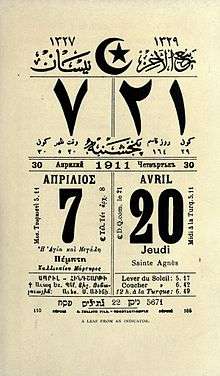
Ottoman Turkish was the official language of the Empire. It was an Oghuz Turkic language highly influenced by Persian and Arabic. The Ottomans had several influential languages: Turkish, spoken by the majority of the people in Anatolia and by the majority of Muslims of the Balkans except in Albania and Bosnia; Persian, only spoken by the educated;[198] Arabic, spoken mainly in Egypt, the Levant, Arabia, Iraq, North Africa, Kuwait and parts of the Horn of Africa and Berber in North Africa. In the last two centuries, usage of these became limited, though, and specific: Persian served mainly as a literary language for the educated,[198] while Arabic was used for Islamic prayers. Turkish, in its Ottoman variation, was a language of military and administration since the nascent days of the Ottomans. The Ottoman constitution of 1876 did officially cement the official imperial status of Turkish.[199] In the post-Tanzimat period French became the common Western language among the educated.[7]
Because of a low literacy rate among the public (about 2–3% until the early 19th century and just about 15% at the end of the 19th century), ordinary people had to hire scribes as "special request-writers" (arzuhâlcis) to be able to communicate with the government.[200] The ethnic groups continued to speak within their families and neighborhoods (mahalles) with their own languages (e.g., Jews, Greeks, Armenians, etc.). In villages where two or more populations lived together, the inhabitants would often speak each other's language. In cosmopolitan cities, people often spoke their family languages; many of those who were not ethnic Turks spoke Turkish as a second language.
Religion

In the Ottoman imperial system, even though there existed a hegemonic power of Muslim control over the non-Muslim populations, non-Muslim communities had been granted state recognition and protection in the Islamic tradition.[201] The officially accepted state Dīn (Madh'hab) of the Ottomans was Sunni (Hanafi jurisprudence).[202]
Until the second half of the 15th century, the empire had a Christian majority, under the rule of a Muslim minority.[166] In the late 19th century, the non-Muslim population of the empire began to fall considerably, not only due to secession, but also because of migratory movements.[201] The proportion of Muslims amounted to 60% in the 1820s, gradually increasing to 69% in the 1870s and then to 76% in the 1890s.[201] By 1914, only 19.1% of the empire's population was non-Muslim, mostly made up of Jews and Christian Greeks, Assyrians, and Armenians.[201]
Islam
Turkic peoples practiced a variety of shamanism before adopting Islam. Abbasid influence in Central Asia was ensured through a process that was greatly facilitated by the Muslim conquest of Transoxiana. Many of the various Turkic tribes—including the Oghuz Turks, who were the ancestors of both the Seljuks and the Ottomans—gradually converted to Islam, and brought the religion with them to Anatolia beginning in the 11th century. Since the founding of the Ottoman Empire, the Ottomans followed the Maturidi creed (school of Islamic theology) and the Hanafi madhab (school of Islamic jurisprudence).[204][205][206]
Muslim sects regarded as heretical, such as the Druze, Ismailis, Alevis, and Alawites, ranked below Jews and Christians.[207] In 1514, Sultan Selim I ordered the massacre of 40,000 Anatolian Alevis (Qizilbash), whom he considered a fifth column for the rival Safavid empire. Selim was also responsible for an unprecedented and rapid expansion of the Ottoman Empire into the Middle East, especially through his conquest of the entire Mamluk Sultanate of Egypt. With these conquests, Selim further solidified the Ottoman claim for being an Islamic caliphate, although Ottoman sultans had been claiming the title of caliph since the 14th century starting with Murad I (reigned 1362 to 1389).[9] The caliphate would remain held by Ottoman sultans for the rest of the office's duration, which ended with its abolition on 3 March 1924 by the Grand National Assembly of Turkey and the exile of the last caliph, Abdülmecid II, to France.
Christianity and Judaism

In the Ottoman Empire, in accordance with the Muslim dhimmi system, Christians were guaranteed limited freedoms (such as the right to worship). They were forbidden to carry weapons or ride on horseback; their houses could not overlook those of Muslims, in addition to various other legal limitations.[208] Many Christians and Jews converted in order to secure full status in the society. Most, however, continued to practice their old religions without restriction.[209]
Under the millet system, non-Muslim people were considered subjects of the Empire but were not subject to the Muslim faith or Muslim law. The Orthodox millet, for instance, was still officially legally subject to Justinian's Code, which had been in effect in the Byzantine Empire for 900 years. Also, as the largest group of non-Muslim subjects (or dhimmi) of the Islamic Ottoman state, the Orthodox millet was granted a number of special privileges in the fields of politics and commerce, and had to pay higher taxes than Muslim subjects.[210][211]
Similar millets were established for the Ottoman Jewish community, who were under the authority of the Haham Başı or Ottoman Chief Rabbi; the Armenian Apostolic community, who were under the authority of a head bishop; and a number of other religious communities as well.[212] Some argue that the millet system is an example of pre-modern religious pluralism.[213]
Social-political-religious structure
Society, government and religion was inter-related in complex ways after about 1800, in a complex overlapping, inefficient system that Atatürk systematically dismantled after 1922.[214][215] In Constantinople, the Sultan ruled two distinct domains: the secular government and the religious hierarchy. Religious officials formed the Ulama, who had control of religious teachings and theology, and also the Empire's judicial system, giving them a major voice in day-to-day affairs in communities across the Empire (but not including the non-Muslim millets). They were powerful enough to reject the military reforms proposed by Sultan Selim III. His successor Sultan Mahmud II (r. 1808–1839) first won ulama approval before proposing similar reforms.[216] The secularization program brought by Atatürk ended the ulema and their institutions. The caliphate was abolished, madrasas were closed down, and the sharia courts abolished. He replaced the Arabic alphabet with Latin letters, ended the religious school system, and gave women some political rights. Many rural traditionalists never accepted this secularization, and by the 1990s they were reasserting a demand for a larger role for Islam.[217]

The Janissaries were a highly formidable military unit in the early years, but as Western Europe modernized its military organization technology, the Janissaries became a reactionary force that resisted all change. Steadily the Ottoman military power became outdated, but when the Janissaries felt their privileges were being threatened, or outsiders wanted to modernize them, or they might be superseded by the cavalrymen, they rose in rebellion. The rebellions were highly violent on both sides, but by the time the Janissaries were suppressed, it was far too late for Ottoman military power to catch up with the West.[218][219] The political system was transformed by the destruction of the Janissaries in the Auspicious Incident of 1826, who were a very powerful military/governmental/police force that revolted. Sultan Mahmud II crushed the revolt, executed the leaders, and disbanded the large organization. That set the stage for a slow process of modernization of government functions, as the government sought, with mixed success, to adopt the main elements of Western bureaucracy and military technology. The Janissaries had been recruited from Christians and other minorities; their abolition enabled the emergence of a Turkish elite to control the Ottoman Empire. The problem was that the Turkish element was very poorly educated, lacking higher schools of any sort, and locked into a Turkish language that used the Arabic alphabet that inhibited wider learning. The large number of ethnic and religious minorities were tolerated in their own separate segregated domains called millets.[220] They were primarily Greek, Armenian, or Jewish. In each locality, they governed themselves, spoke their own language, ran their own schools, cultural and religious institutions, and paid somewhat higher taxes. They had no power outside the millet. The Imperial government protected them and prevented major violent clashes between ethnic groups. However, the millets showed very little loyalty to the Empire. Ethnic nationalism, based on distinctive religion and language, provided a centripetal force that eventually destroyed the Ottoman Empire.[221] In addition, Muslim ethnic groups, which were not part of the millett system, especially the Arabs and the Kurds, were outside the Turkish culture and developed their own separate nationalism. The British sponsored Arab nationalism in the First World War, promising an independent Arab state in return for Arab support. Most Arabs supported the Sultan, but those near Mecca believed in and supported the British promise.[222]
At the local level, power was held beyond the control of the Sultan by the "ayan" or local notables. The ayan collected taxes, formed local armies to compete with other notables, took a reactionary attitude toward political or economic change, and often defied policies handed down by the Sultan.[223]
The economic system made little progress. Printing was forbidden until the 18th century, for fear of defiling the secret documents of Islam. The millets, however, were allowed their own presses, using Greek, Hebrew, Armenian and other languages that greatly facilitated nationalism. The religious prohibition on charging interest foreclosed most of the entrepreneurial skills among Muslims, although it did flourish among the Jews and Christians.
After the 18th century, the Ottoman Empire was clearly shrinking, as Russia put on heavy pressure and expanded to its south; Egypt became effectively independent in 1805, and the British later took it over, along with Cyprus. Greece became independent, and Serbia and other Balkan areas became highly restive as the force of nationalism pushed against imperialism. The French took over Algeria and Tunisia. The Europeans all thought that the empire was a sick man in rapid decline. Only the Germans seemed helpful, and their support led to the Ottoman Empire joining the central powers in 1915, with the end result that they came out as one of the heaviest losers of the First World War in 1918.[224]
Culture
| Culture of the Ottoman Empire |
|---|
 |
| Visual arts |
|
| Performing arts |
| Languages and literature |
| Sports |
| Other |
The Ottomans absorbed some of the traditions, art, and institutions of cultures in the regions they conquered and added new dimensions to them. Numerous traditions and cultural traits of previous empires (In fields such as architecture, cuisine, music, leisure, and government) were adopted by the Ottoman Turks, who developed them into new forms, resulting in a new and distinctively Ottoman cultural identity. Despite newer added amalgamations, the Ottoman dynasty, like their predecessors in the Sultanate of Rum and the Seljuk Empire, were thoroughly Persianised in their culture, language, habits, and customs, and therefore the empire has been described as a Persianate empire.[225][17][18][226] Intercultural marriages also played a part in creating the characteristic Ottoman elite culture. When compared to the Turkish folk culture, the influence of these new cultures in creating the culture of the Ottoman elite was clear.
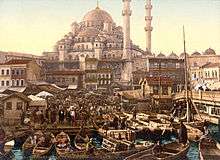
Slavery was a part of Ottoman society,[227] with most slaves employed as domestic servants. Agricultural slavery, such as that which was widespread in the Americas, was relatively rare. Unlike systems of chattel slavery, slaves under Islamic law were not regarded as movable property, but maintained basic, though limited, rights. This gave them a degree of protection against abuse.[228] Female slaves were still sold in the Empire as late as 1908.[229] During the 19th century the Empire came under pressure from Western European countries to outlaw the practice. Policies developed by various Sultans throughout the 19th century attempted to curtail the Ottoman slave trade but slavery had centuries of religious backing and sanction and so slavery was never abolished in the Empire.[212]
Plague remained a major scourge in Ottoman society until the second quarter of the 19th century. "Between 1701 and 1750, 37 larger and smaller plague epidemics were recorded in Istanbul, and 31 between 1751 and 1801."[230]
Ottomans adopted Persian bureaucratic traditions and culture. The sultans also made an important contribution in the development of Persian literature.[231]
Education
In the Ottoman Empire, each millet established a schooling system serving its members.[232] Education, therefore, was largely divided on ethnic and religious lines: few non-Muslims attended schools for Muslim students and vice versa. Most institutions that did serve all ethnic and religious groups taught in French or other languages.[233]
Literature
The two primary streams of Ottoman written literature are poetry and prose. Poetry was by far the dominant stream. Until the 19th century, Ottoman prose did not contain any examples of fiction: there were no counterparts to, for instance, the European romance, short story, or novel. Analogue genres did exist, though, in both Turkish folk literature and in Divan poetry.
Ottoman Divan poetry was a highly ritualized and symbolic art form. From the Persian poetry that largely inspired it, it inherited a wealth of symbols whose meanings and interrelationships—both of similitude (مراعات نظير mura'ât-i nazîr / تناسب tenâsüb) and opposition (تضاد tezâd) were more or less prescribed. Divan poetry was composed through the constant juxtaposition of many such images within a strict metrical framework, thus allowing numerous potential meanings to emerge. The vast majority of Divan poetry was lyric in nature: either gazels (which make up the greatest part of the repertoire of the tradition), or kasîdes. There were, however, other common genres, most particularly the mesnevî, a kind of verse romance and thus a variety of narrative poetry; the two most notable examples of this form are the Leyli and Majnun of Fuzûlî and the Hüsn ü Aşk of Şeyh Gâlib.
Until the 19th century, Ottoman prose did not develop to the extent that contemporary Divan poetry did. A large part of the reason for this was that much prose was expected to adhere to the rules of sec (سجع, also transliterated as seci), or rhymed prose,[234] a type of writing descended from the Arabic saj' and which prescribed that between each adjective and noun in a string of words, such as a sentence, there must be a rhyme. Nevertheless, there was a tradition of prose in the literature of the time, though exclusively non-fictional in nature. One apparent exception was Muhayyelât ("Fancies") by Giritli Ali Aziz Efendi, a collection of stories of the fantastic written in 1796, though not published until 1867. The first novel published in the Ottoman Empire was by an Armenian named Vartan Pasha. Published in 1851, the novel was entitled The Story of Akabi (Turkish: Akabi Hikyayesi) and was written in Turkish but with Armenian script.[235][236][237][238]
Due to historically close ties with France, French literature came to constitute the major Western influence on Ottoman literature throughout the latter half of the 19th century. As a result, many of the same movements prevalent in France during this period also had their Ottoman equivalents; in the developing Ottoman prose tradition, for instance, the influence of Romanticism can be seen during the Tanzimat period, and that of the Realist and Naturalist movements in subsequent periods; in the poetic tradition, on the other hand, it was the influence of the Symbolist and Parnassian movements that became paramount.
Many of the writers in the Tanzimat period wrote in several different genres simultaneously; for instance, the poet Namık Kemal also wrote the important 1876 novel İntibâh ("Awakening"), while the journalist İbrahim Şinasi is noted for writing, in 1860, the first modern Turkish play, the one-act comedy "Şair Evlenmesi" ("The Poet's Marriage"). An earlier play, a farce entitled "Vakâyi'-i 'Acibe ve Havâdis-i Garibe-yi Kefşger Ahmed" ("The Strange Events and Bizarre Occurrences of the Cobbler Ahmed"), dates from the beginning of the 19th century, but there remains some doubt about its authenticity. In a similar vein, the novelist Ahmed Midhat Efendi wrote important novels in each of the major movements: Romanticism (Hasan Mellâh yâhud Sırr İçinde Esrâr, 1873; "Hasan the Sailor, or The Mystery Within the Mystery"), Realism (Henüz On Yedi Yaşında, 1881; "Just Seventeen Years Old"), and Naturalism (Müşâhedât, 1891; "Observations"). This diversity was, in part, due to the Tanzimat writers' wish to disseminate as much of the new literature as possible, in the hopes that it would contribute to a revitalization of Ottoman social structures.[239]
Media
Architecture
Ottoman architecture was influenced by Persian, Byzantine Greek and Islamic architectures. During the Rise period (The early or first Ottoman architecture period), Ottoman art was in search of new ideas. The growth period of the Empire became the classical period of architecture when Ottoman art was at its most confident. During the years of the Stagnation period, Ottoman architecture moved away from this style, however. During the Tulip Era, it was under the influence of the highly ornamented styles of Western Europe; Baroque, Rococo, Empire and other styles intermingled. Concepts of Ottoman architecture concentrate mainly on the mosque. The mosque was integral to society, city planning, and communal life. Besides the mosque, it is also possible to find good examples of Ottoman architecture in soup kitchens, theological schools, hospitals, Turkish baths, and tombs.
 The main entrance of Dolmabahçe Palace that is built in 1862
The main entrance of Dolmabahçe Palace that is built in 1862

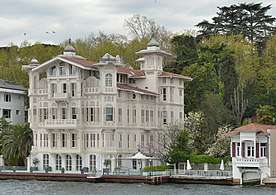 Yalı is a house or mansion constructed at immediate waterside on the Bosphorus strait in Istanbul
Yalı is a house or mansion constructed at immediate waterside on the Bosphorus strait in Istanbul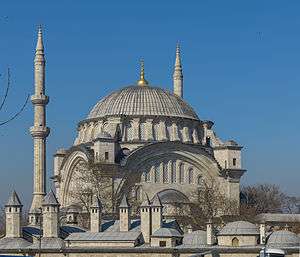 Nuruosmaniye Mosque
Nuruosmaniye Mosque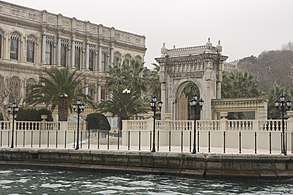
.jpg)
.jpg) Odunpazarı in Eskişehir has the best examples of the civil Ottoman architecture
Odunpazarı in Eskişehir has the best examples of the civil Ottoman architecture- Odunpazarı in Eskişehir has the best examples of the civil Ottoman architecture
Examples of Ottoman architecture of the classical period, besides Istanbul and Edirne, can also be seen in Egypt, Eritrea, Tunisia, Algiers, the Balkans, and Romania, where mosques, bridges, fountains, and schools were built. The art of Ottoman decoration developed with a multitude of influences due to the wide ethnic range of the Ottoman Empire. The greatest of the court artists enriched the Ottoman Empire with many pluralistic artistic influences, such as mixing traditional Byzantine art with elements of Chinese art.[240]
Decorative arts
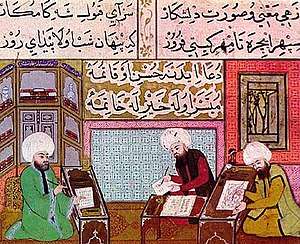

The tradition of Ottoman miniatures, painted to illustrate manuscripts or used in dedicated albums, was heavily influenced by the Persian art form, though it also included elements of the Byzantine tradition of illumination and painting. A Greek academy of painters, the Nakkashane-i-Rum, was established in the Topkapi Palace in the 15th century, while early in the following century a similar Persian academy, the Nakkashane-i-Irani, was added.
Ottoman illumination covers non-figurative painted or drawn decorative art in books or on sheets in muraqqa or albums, as opposed to the figurative images of the Ottoman miniature. It was a part of the Ottoman Book Arts together with the Ottoman miniature (taswir), calligraphy (hat), Islamic calligraphy, bookbinding (cilt) and paper marbling (ebru). In the Ottoman Empire, illuminated and illustrated manuscripts were commissioned by the Sultan or the administrators of the court. In Topkapi Palace, these manuscripts were created by the artists working in Nakkashane, the atelier of the miniature and illumination artists. Both religious and non-religious books could be illuminated. Also, sheets for albums levha consisted of illuminated calligraphy (hat) of tughra, religious texts, verses from poems or proverbs, and purely decorative drawings.
The art of carpet weaving was particularly significant in the Ottoman Empire, carpets having an immense importance both as decorative furnishings, rich in religious and other symbolism and as a practical consideration, as it was customary to remove one's shoes in living quarters.[241] The weaving of such carpets originated in the nomadic cultures of central Asia (carpets being an easily transportable form of furnishing), and eventually spread to the settled societies of Anatolia. Turks used carpets, rugs, and kilims not just on the floors of a room but also as a hanging on walls and doorways, where they provided additional insulation. They were also commonly donated to mosques, which often amassed large collections of them.[242]
Music and performing arts
Ottoman classical music was an important part of the education of the Ottoman elite. A number of the Ottoman sultans were accomplished musicians and composers themselves, such as Selim III, whose compositions are often still performed today. Ottoman classical music arose largely from a confluence of Byzantine music, Armenian music, Arabic music, and Persian music. Compositionally, it is organised around rhythmic units called usul, which are somewhat similar to meter in Western music, and melodic units called makam, which bear some resemblance to Western musical modes.
The instruments used are a mixture of Anatolian and Central Asian instruments (the saz, the bağlama, the kemence), other Middle Eastern instruments (the ud, the tanbur, the kanun, the ney), and—later in the tradition—Western instruments (the violin and the piano). Because of a geographic and cultural divide between the capital and other areas, two broadly distinct styles of music arose in the Ottoman Empire: Ottoman classical music and folk music. In the provinces, several different kinds of folk music were created. The most dominant regions with their distinguished musical styles are Balkan-Thracian Türküs, North-Eastern (Laz) Türküs, Aegean Türküs, Central Anatolian Türküs, Eastern Anatolian Türküs, and Caucasian Türküs. Some of the distinctive styles were: Janissary Music, Roma music, Belly dance, Turkish folk music.
The traditional shadow play called Karagöz and Hacivat was widespread throughout the Ottoman Empire and featured characters representing all of the major ethnic and social groups in that culture.[243][244] It was performed by a single puppet master, who voiced all of the characters, and accompanied by tambourine (def). Its origins are obscure, deriving perhaps from an older Egyptian tradition, or possibly from an Asian source.
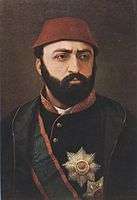 Sultan Abdülaziz was also a music composer.
Sultan Abdülaziz was also a music composer.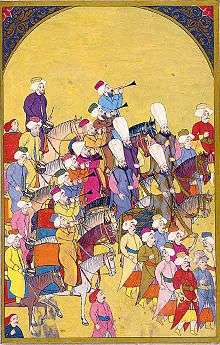
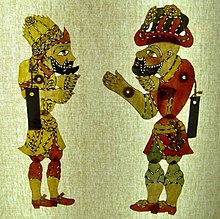 The shadow play Karagöz and Hacivat was widespread throughout the Ottoman Empire.
The shadow play Karagöz and Hacivat was widespread throughout the Ottoman Empire.
Cuisine
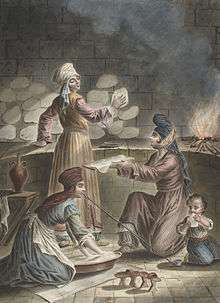
Ottoman cuisine refers to the cuisine of the capital, Constantinople (Istanbul), and the regional capital cities, where the melting pot of cultures created a common cuisine that most of the population regardless of ethnicity shared. This diverse cuisine was honed in the Imperial Palace's kitchens by chefs brought from certain parts of the Empire to create and experiment with different ingredients. The creations of the Ottoman Palace's kitchens filtered to the population, for instance through Ramadan events, and through the cooking at the Yalıs of the Pashas, and from there on spread to the rest of the population.
Much of the cuisine of former Ottoman territories today is descended from a shared Ottoman cuisine, especially Turkish, and including Greek, Balkan, Armenian, and Middle Eastern cuisines.[245] Many common dishes in the region, descendants of the once-common Ottoman cuisine, include yogurt, döner kebab/gyro/shawarma, cacık/tzatziki, ayran, pita bread, feta cheese, baklava, lahmacun, moussaka, yuvarlak, köfte/keftés/kofta, börek/boureki, rakı/rakia/tsipouro/tsikoudia, meze, dolma, sarma, rice pilaf, Turkish coffee, sujuk, kashk, keşkek, manti, lavash, kanafeh, and more.
Science and technology
.jpg)
Over the course of Ottoman history, the Ottomans managed to build a large collection of libraries complete with translations of books from other cultures, as well as original manuscripts.[52] A great part of this desire for local and foreign manuscripts arose in the 15th century. Sultan Mehmet II ordered Georgios Amiroutzes, a Greek scholar from Trabzon, to translate and make available to Ottoman educational institutions the geography book of Ptolemy. Another example is Ali Qushji – an astronomer, mathematician and physicist originally from Samarkand – who became a professor in two madrasas and influenced Ottoman circles as a result of his writings and the activities of his students, even though he only spent two or three years in Constantinople before his death.[246]
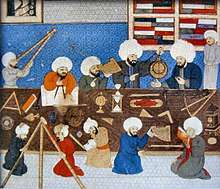
Taqi al-Din built the Constantinople observatory of Taqi al-Din in 1577, where he carried out observations until 1580. He calculated the eccentricity of the Sun's orbit and the annual motion of the apogee.[247] However, the observatory's primary purpose was almost certainly astrological rather than astronomical, leading to its destruction in 1580 due to the rise of a clerical faction that opposed its use for that purpose.[248] He also experimented with steam power in Ottoman Egypt in 1551, when he described a steam jack driven by a rudimentary steam turbine.[249]
In 1660 the Ottoman scholar Ibrahim Efendi al-Zigetvari Tezkireci translated Noël Duret's French astronomical work (written in 1637) into Arabic.[250]
Şerafeddin Sabuncuoğlu was the author of the first surgical atlas and the last major medical encyclopedia from the Islamic world. Though his work was largely based on Abu al-Qasim al-Zahrawi's Al-Tasrif, Sabuncuoğlu introduced many innovations of his own. Female surgeons were also illustrated for the first time.[251]
An example of a watch that measured time in minutes was created by an Ottoman watchmaker, Meshur Sheyh Dede, in 1702.[252]
In the early 19th century, Egypt under Muhammad Ali began using steam engines for industrial manufacturing, with industries such as ironworks, textile manufacturing, paper mills and hulling mills moving towards steam power.[253] Economic historian Jean Batou argues that the necessary economic conditions existed in Egypt for the adoption of oil as a potential energy source for its steam engines later in the 19th century.[253]
In the 19th century, Ishak Efendi is credited with introducing the then current Western scientific ideas and developments to the Ottoman and wider Muslim world, as well as the invention of a suitable Turkish and Arabic scientific terminology, through his translations of Western works.
Sports
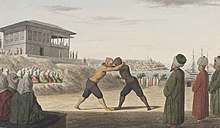
The main sports Ottomans were engaged in were Turkish wrestling, hunting, Turkish archery, horseback riding, equestrian javelin throw, arm wrestling, and swimming. European model sports clubs were formed with the spreading popularity of football matches in 19th century Constantinople. The leading clubs, according to timeline, were Beşiktaş Gymnastics Club (1903), Galatasaray Sports Club (1905), Fenerbahçe Sports Club (1907), MKE Ankaragücü (formerly Turan Sanatkaragücü) (1910) in Constantinople. Football clubs were formed in other provinces too, such as Karşıyaka Sports Club (1912), Altay Sports Club (1914) and Turkish Fatherland Football Club (later Ülküspor) (1914) of İzmir.
See also
- Age of the Islamic Gunpowders
- Bibliography of the Ottoman Empire
- Military of the Ottoman Empire
- Historiography of the fall of the Ottoman Empire
- History of the Turkic peoples
- Index of Ottoman Empire-related articles
- List of Ottoman conquests, sieges and landings
- List of Turkic dynasties and countries
- Outline of the Ottoman Empire
- Ottoman Tunisia
- 16 Great Turkic Empires
- List of wars involving the Ottoman Empire
- List of battles involving the Ottoman Empire
- Ottoman wars in Europe
Notes
- In Ottoman Turkish, the city was known by various names, among which were Kostantiniyye (قسطنطينيه) (replacing the suffix -polis with the Arabic nisba), Dersaadet (در سعادت) and Istanbul (استانبول). Names other than Istanbul became obsolete in Turkish after the proclamation of the Republic of Turkey in 1923,[3] and after Turkey's transition to Latin script in 1928, the Turkish government in 1930 requested that foreign embassies and companies use Istanbul, and that name became widely accepted internationally.[4] Eldem Edhem, author of an entry on Istanbul in Encyclopedia of the Ottoman Empire, stated that the majority of the Turkish people circa 2010, including historians, believe using "Constantinople" to refer to the Ottoman-era city is "politically incorrect" despite any historical accuracy.[3]
- The sultan from 1512 to 1520.
- Mehmed VI, the last Sultan, was expelled from Constantinople on 17 November 1922.
- The Treaty of Sèvres (10 August 1920) afforded a small existence to the Ottoman Empire. On 1 November 1922, the Grand National Assembly (GNAT) abolished the sultanate and declared that all the deeds of the Ottoman regime in Constantinople were null and void as of 16 March 1920, the date of the occupation of Constantinople under the terms of the Treaty of Sèvres. The international recognition of the GNAT and the Government of Ankara was achieved through the signing of the Treaty of Lausanne on 24 July 1923. The Grand National Assembly of Turkey promulgated the Republic on 29 October 1923, which ended the Ottoman Empire in history.
- "Sublime Ottoman State" was not used in minority languages for Christians and Jews, nor in French,[13] the common Western language among the educated in the late Ottoman Empire.[7] Minority languages, which use the same name in French:[13]
- Western Armenian: Օսմանյան տերութիւն (Osmanean Têrut´iwn, meaning "Ottoman Authority/Governance/Rule"), Օսմանյան պետութիւն (Osmanean Petut‘iwn, meaning "Ottoman State"), and Օսմանյան կայսրություն (Osmanean Kaysrut, meaning "Ottoman Empire")
- Bulgarian: Османска империя (Otomanskata Imperiya), and Отоманска империя is an archaic version. Definite article forms: Османската империя and Османска империя were synonymous
- Greek: Оθωμανική Επικράτεια (Othōmanikē Epikrateia) and Оθωμανική Αυτοκρατορία (Othōmanikē Avtokratoria)
- Ladino: Imperio otomano
- The empire also temporarily gained authority over distant overseas lands through declarations of allegiance to the Ottoman Sultan and Caliph, such as the declaration by the Sultan of Aceh in 1565, or through temporary acquisitions of islands such as Lanzarote in the Atlantic Ocean in 1585, Turkish Navy Official Website: "Atlantik'te Türk Denizciliği"
- A lock-hold on trade between western Europe and Asia is often cited as a primary motivation for Isabella I of Castile to fund Christopher Columbus's westward journey to find a sailing route to Asia and, more generally, for European seafaring nations to explore alternative trade routes (e.g., K.D. Madan, Life and travels of Vasco Da Gama (1998), 9; I. Stavans, Imagining Columbus: the literary voyage (2001), 5; W.B. Wheeler and S. Becker, Discovering the American Past. A Look at the Evidence: to 1877 (2006), 105). This traditional viewpoint has been attacked as unfounded in an influential article by A.H. Lybyer ("The Ottoman Turks and the Routes of Oriental Trade", English Historical Review, 120 (1915), 577–88), who sees the rise of Ottoman power and the beginnings of Portuguese and Spanish explorations as unrelated events. His view has not been universally accepted (cf. K.M. Setton, The Papacy and the Levant (1204–1571), Vol. 2: The Fifteenth Century (Memoirs of the American Philosophical Society, Vol. 127) (1978), 335).
- Although his sons ‘Ali and Faisal had already initiated operations at Medina starting on 5 June[146]
References
- Stanford Shaw, History of the Ottoman Empire and Modern Turkey (Cambridge: University Press, 1976), vol. 1 p. 13
- "In 1363 the Ottoman capital moved from Bursa to Edirne, although Bursa retained its spiritual and economic importance." Ottoman Capital Bursa. Official website of Ministry of Culture and Tourism of the Republic of Turkey. Retrieved 26 June 2013.
- Edhem, Eldem. "Istanbul." In: Ágoston, Gábor and Bruce Alan Masters. Encyclopedia of the Ottoman Empire. Infobase Publishing, 21 May 2010. ISBN 1438110251, 9781438110257. Start and CITED: p. 286. "With the collapse of the Ottoman Empire and the establishment of the Republic of Turkey, all previous names were abandoned and Istanbul came to designate the entire city."
- (Stanford and Ezel Shaw (27 May 1977): History of the Ottoman Empire and Modern Turkey. Cambridge: Cambridge University Press. Vol II, ISBN 0521291666, 9780521291668. p. 386; Robinson (1965), The First Turkish Republic, p. 298 and Society (4 March 2014). "Istanbul, not Constantinople". National Geographic Society. Retrieved 28 March 2019.)
- Flynn, Thomas O. (7 August 2017). The Western Christian Presence in the Russias and Qājār Persia, c.1760–c.1870. BRILL. ISBN 9789004313545.
-
- Greek (Some of the sultans and among Greek-speaking community)
- Learning to Read in the Late Ottoman Empire and the Early Turkish Republic, B. Fortna, page 50;"Although in the late Ottoman period Persian was taught in the state schools...."
- Persian Historiography and Geography, Bertold Spuler, page 68, "On the whole, the circumstance in Turkey took a similar course: in Anatolia, the Persian language had played a significant role as the carrier of civilization.[..]..where it was at time, to some extent, the language of diplomacy...However Persian maintained its position also during the early Ottoman period in the composition of histories and even Sultan Salim I, a bitter enemy of Iran and the Shi'ites, wrote poetry in Persian. Besides some poetical adaptations, the most important historiographical works are: Idris Bidlisi's flowery "Hasht Bihist", or Seven Paradises, begun in 1502 by the request of Sultan Bayazid II and covering the first eight Ottoman rulers.."
- Picturing History at the Ottoman Court, Emine Fetvacı, page 31, "Persian literature, and belles-lettres in particular, were part of the curriculum: a Persian dictionary, a manual on prose composition; and Sa'dis "Gulistan", one of the classics of Persian poetry, were borrowed. All these title would be appropriate in the religious and cultural eudcation of the newly converted young men.
- Persian Historiography: History of Persian Literature A, Volume 10, edited by Ehsan Yarshater, Charles Melville, page 437;"...Persian held a privileged place in Ottoman letters. Persian historical literature was first patronized during the reign of Mehmed II and continued unabated until the end of the 16th century.
- Strauss, Johann (2010). "A Constitution for a Multilingual Empire: Translations of the Kanun-ı Esasi and Other Official Texts into Minority Languages". In Herzog, Christoph; Malek Sharif (eds.). The First Ottoman Experiment in Democracy. Wurzburg: Orient-Institut Istanbul. pp. 21–51. (info page on book at Martin Luther University) // CITED: p. 26 (PDF p. 28): "French had become a sort of semi-official language in the Ottoman Empire in the wake of the Tanzimat reforms.[...]It is true that French was not an ethnic language of the Ottoman Empire. But it was the only Western language which would become increasingly widespread among educated persons in all linguistic communities."
- Finkel, Caroline (2005). Osman's Dream: The Story of the Ottoman Empire, 1300-1923. New York: Basic Books. pp. 110–1. ISBN 978-0-465-02396-7.
- Lambton, Ann; Lewis, Bernard (1995). The Cambridge History of Islam: The Indian sub-continent, South-East Asia, Africa and the Muslim west. 2. Cambridge University Press. p. 320. ISBN 978-0-521-22310-2.
- Rein Taagepera (September 1997). "Expansion and Contraction Patterns of Large Polities: Context for Russia". International Studies Quarterly. 41 (3): 498. doi:10.1111/0020-8833.00053. JSTOR 2600793.
- Turchin, Peter; Adams, Jonathan M.; Hall, Thomas D (December 2006). "East-West Orientation of Historical Empires". Journal of World-Systems Research. 12 (2): 223. ISSN 1076-156X. Retrieved 12 September 2016.
- Erickson, Edward J. (2003). Defeat in Detail: The Ottoman Army in the Balkans, 1912–1913. Greenwood Publishing Group. p. 59. ISBN 978-0-275-97888-4.
- Strauss, Johann (2010). "A Constitution for a Multilingual Empire: Translations of the Kanun-ı Esasi and Other Official Texts into Minority Languages". In Herzog, Christoph; Malek Sharif (eds.). The First Ottoman Experiment in Democracy. Wurzburg: Orient-Institut Istanbul. pp. 21–51. (info page on book at Martin Luther University) // CITED: p. 36 (PDF p. 38/338).
- A ́goston, Ga ́bor; Masters, Bruce Alan (2008). Encyclopedia of the Ottoman Empire. Infobase Publishing, NY. p. 444. ISBN 0-8160--6259-5. "Osman was simply one among a number Turkoman tribal leaders operating in the Sakarya region."
- "Osman I". Encyclopedia Britannica. Osman I, also called Osman Gazi, (born c. 1258—died 1324 or 1326), ruler of a Turkmen principality in northwestern Anatolia who is regarded as the founder of the Ottoman Turkish state.
- Finkel, Caroline (13 February 2006). Osman's Dream: The Story of the Ottoman Empire, 1300–1923. Basic Books. pp. 2, 7. ISBN 978-0-465-02396-7.
- "Persian in service of the state: the role of Persophone historical writing in the development of an Ottoman imperial aesthetic", Studies on Persianate Societies, 2, 2004, pp. 145–63
- "Historiography. xi. Persian Historiography in the Ottoman Empire". Encyclopaedia Iranica. 12, fasc. 4. 2004. pp. 403–11.
- Özgündenli, O. "Persian Manuscripts in Ottoman and Modern Turkish Libraries". Encyclopaedia Iranica (online ed.).
- Walter, F. "7: The Departure of Turkey from the 'Persianate' Musical Sphere". Music of the Ottoman court.
- Quataert, Donald (2005). The Ottoman Empire, 1700–1922 (2 ed.). Cambridge University Press. p. 4. ISBN 978-0-521-83910-5.
- "Ottoman Empire". Oxford Islamic Studies Online. 6 May 2008. Retrieved 26 August 2010.
- Hathaway, Jane (2008). The Arab Lands under Ottoman Rule, 1516–1800. Pearson Education Ltd. p. 8. ISBN 978-0-582-41899-8.
historians of the Ottoman Empire have rejected the narrative of decline in favor of one of crisis and adaptation
- Tezcan, Baki (2010). The Second Ottoman Empire: Political and Social Transformation in the Early Modern Period. Cambridge University Press. p. 9. ISBN 978-1-107-41144-9.
Ottomanist historians have produced several works in the last decades, revising the traditional understanding of this period from various angles, some of which were not even considered as topics of historical inquiry in the mid-twentieth century. Thanks to these works, the conventional narrative of Ottoman history – that in the late sixteenth century the Ottoman Empire entered a prolonged period of decline marked by steadily increasing military decay and institutional corruption – has been discarded.
- Woodhead, Christine (2011). "Introduction". In Christine Woodhead (ed.). The Ottoman World. p. 5. ISBN 978-0-415-44492-7.
Ottomanist historians have largely jettisoned the notion of a post-1600 ‘decline’
- Tezcan, Baki (2010). The Second Ottoman Empire: Political and Social Transformation in the Early Modern Period. Cambridge University Press. p. 9. ISBN 978-1-107-41144-9.
- Ágoston, Gábor (2009). "Introduction". In Ágoston, Gábor; Bruce Masters (eds.). Encyclopedia of the Ottoman Empire. p. xxxii.
- Faroqhi, Suraiya (1994). "Crisis and Change, 1590–1699". In İnalcık, Halil; Donald Quataert (eds.). An Economic and Social History of the Ottoman Empire, 1300–1914. 2. Cambridge University Press. p. 553. ISBN 978-0-521-57456-3.
In the past fifty years, scholars have frequently tended to view this decreasing participation of the sultan in political life as evidence for "Ottoman decadence", which supposedly began at some time during the second half of the sixteenth century. But recently, more note has been taken of the fact that the Ottoman Empire was still a formidable military and political power throughout the seventeenth century, and that noticeable though limited economic recovery followed the crisis of the years around 1600; after the crisis of the 1683–99 war, there followed a longer and more decisive economic upswing. Major evidence of decline was not visible before the second half of the eighteenth century.
- Faroqhi, Suraiya (1994). "Crisis and Change, 1590–1699". In İnalcık, Halil; Donald Quataert (eds.). An Economic and Social History of the Ottoman Empire, 1300–1914. 2. Cambridge University Press. p. 553. ISBN 978-0-521-57456-3.
- Aksan, Virginia (2007). Ottoman Wars, 1700–1860: An Empire Besieged. Pearson Education Ltd. pp. 130–35. ISBN 978-0-582-30807-7.
- Quataert, Donald (1994). "The Age of Reforms, 1812–1914". In İnalcık, Halil; Donald Quataert (eds.). An Economic and Social History of the Ottoman Empire, 1300–1914. 2. Cambridge University Press. p. 762. ISBN 978-0-521-57456-3.
- Findley, Carter Vaughn (2010). Turkey, Islam, Nationalism and Modernity: A History, 1789–2007. New Haven: Yale University Press. p. 200. ISBN 978-0-300-15260-9.
-
• Quataert, Donald (2005). The Ottoman Empire, 1700–1922. Cambridge University Press (Kindle edition). p. 186.
• Schaller, Dominik J; Zimmerer, Jürgen (2008). "Late Ottoman genocides: the dissolution of the Ottoman Empire and Young Turkish population and extermination policies – introduction". Journal of Genocide Research. 10 (1): 7–14. doi:10.1080/14623520801950820. - Howard, Douglas A. (2016). A History of the Ottoman Empire. Cambridge University Press. p. 318. ISBN 978-1-108-10747-1.
- "Ottoman banknote with Arabic script". Retrieved 26 August 2010.
- Ágoston, Gábor (2009). "Introduction". In Ágoston, Gábor; Bruce Masters (eds.). Encyclopedia of the Ottoman Empire. p. xxvi.
- Imber, Colin (2009). The Ottoman Empire, 1300–1650: The Structure of Power (2 ed.). New York: Palgrave Macmillan. p. 3.
By the seventeenth century, literate circles in Istanbul would not call themselves Turks, and often, in phrases such as 'senseless Turks', used the word as a term of abuse.
- Imber, Colin (2009). The Ottoman Empire, 1300–1650: The Structure of Power (2 ed.). New York: Palgrave Macmillan. p. 3.
- Kafadar, Cemal (2007). "A Rome of One's Own: Cultural Geography and Identity in the Lands of Rum". Muqarnas. 24: 11.
- Greene, Molly (2015). The Edinburgh History of the Greeks, 1453 to 1768. p. 51.
- Soucek, Svat (2015). Ottoman Maritime Wars, 1416–1700. Istanbul: The Isis Press. p. 8. ISBN 978-975-428-554-3.
The scholarly community specializing in Ottoman studies has of late virtually banned the use of "Turkey", "Turks", and "Turkish" from acceptable vocabulary, declaring "Ottoman" and its expanded use mandatory and permitting its "Turkish" rival only in linguistic and philological contexts.
- Kermeli, Eugenia (2009). "Osman I". In Ágoston, Gábor; Bruce Masters (eds.). Encyclopedia of the Ottoman Empire. p. 444.
- Lowry, Heath (2003). The Nature of the Early Ottoman State. SUNY Press. p. 59.
- Kafadar, Cemal (1995). Between Two Worlds: The Construction of the Ottoman State. p. 127.
- Finkel, Caroline (2005). Osman's Dream: The History of the Ottoman Empire. Basic Books. pp. 5, 10. ISBN 978-0-465-00850-6.
- Lindner, Rudi Paul (2009). "Anatolia, 1300–1451". In Kate Fleet (ed.). The Cambridge History of Turkey. 1, Byzantium to Turkey, 1071–1453. Cambridge: Cambridge University Press. p. 104.
- Robert Elsie (2004). Historical Dictionary of Kosova. Scarecrow Press. pp. 95–96. ISBN 978-0-8108-5309-6.
- David Nicolle (1999). Nicopolis 1396: The Last Crusade. Osprey Publishing. ISBN 978-1-85532-918-8.
- Gábor Ágoston; Bruce Alan Masters (2009). Encyclopedia of the Ottoman Empire. Infobase Publishing. p. 363. ISBN 978-1-4381-1025-7.
- Mesut Uyar; Edward J. Erickson (2009). A Military History of the Ottomans: From Osman to Atatürk. ABC-CLIO. p. 29. ISBN 978-0-275-98876-0.
- Lokman (1588). "Battle of Mohács (1526)". Archived from the original on 29 May 2013.
- Stone, Norman (2005). "Turkey in the Russian Mirror". In Mark Erickson, Ljubica Erickson (ed.). Russia War, Peace And Diplomacy: Essays in Honour of John Erickson. Weidenfeld & Nicolson. p. 94. ISBN 978-0-297-84913-1. Retrieved 11 February 2013.
- Hodgkinson 2005, p. 240
- Karpat, Kemal H. (1974). The Ottoman state and its place in world history. Leiden: Brill. p. 111. ISBN 978-90-04-03945-2.
- Savory, R. M. (1960). "The Principal Offices of the Ṣafawid State during the Reign of Ismā'īl I (907–30/1501–24)". Bulletin of the School of Oriental and African Studies, University of London. 23 (1): 91–105. doi:10.1017/S0041977X00149006. JSTOR 609888.CS1 maint: ref=harv (link)
- Hess, Andrew C. (January 1973). "The Ottoman Conquest of Egypt (1517) and the Beginning of the Sixteenth-Century World War". International Journal of Middle East Studies. 4 (1): 55–76. doi:10.1017/S0020743800027276. JSTOR 162225.CS1 maint: ref=harv (link)
- "Origins of the Magyars". Hungary. Britannica Online Encyclopedia. Retrieved 26 August 2010.
- "Encyclopædia Britannica". Britannica Online Encyclopedia. Retrieved 26 August 2010.
- Imber, Colin (2002). The Ottoman Empire, 1300–1650: The Structure of Power. Palgrave Macmillan. p. 50. ISBN 978-0-333-61386-3.
- Thompson, Bard (1996). Humanists and Reformers: A History of the Renaissance and Reformation. Wm. B. Eerdmans Publishing. p. 442. ISBN 978-0-8028-6348-5.
- Ágoston and Alan Masters, Gábor and Bruce (2009). Encyclopedia of the Ottoman Empire. Infobase Publishing. p. 583. ISBN 978-1-4381-1025-7.
- The Reign of Suleiman the Magnificent, 1520–1566, V.J. Parry, A History of the Ottoman Empire to 1730, ed. M.A. Cook (Cambridge University Press, 1976), 94.
- A Global Chronology of Conflict: From the Ancient World to the Modern Middle East, Vol. II, ed. Spencer C. Tucker, (ABC-CLIO, 2010). 516.
- Revival: A History of the Art of War in the Sixteenth Century (1937). Routledge. 2018.
- Imber, Colin (2002). The Ottoman Empire, 1300–1650: The Structure of Power. Palgrave Macmillan. p. 53. ISBN 978-0-333-61386-3.
- Ágoston, Gábor (2009). "Süleyman I". In Ágoston, Gábor; Bruce Masters (eds.). Encyclopedia of the Ottoman Empire. p. 545.
- Mansel, Philip (1997). Constantinople : city of the world's desire 1453–1924. London: Penguin Books. p. 61. ISBN 978-0-14-026246-9.
- Crowley, Roger Empires of the Sea: The siege of Malta, the battle of Lepanto and the contest for the center of the world, Random House, 2008
- "The Ottoman 'Discovery' of the Indian Ocean in the Sixteenth Century: The Age of Exploration from an Islamic Perspective". historycooperative.org. Retrieved 11 September 2019.
- Charles A. Truxillo (2012), Jain Publishing Company, "Crusaders in the Far East: The Moro Wars in the Philippines in the Context of the Ibero-Islamic World War".
- Palabiyik, Hamit, Turkish Public Administration: From Tradition to the Modern Age, (Ankara, 2008), 84.
- Ismail Hakki Goksoy. Ottoman-Aceh Relations According to the Turkish Sources (PDF). Archived from the original (PDF) on 19 January 2008. Retrieved 16 December 2018.
- Deringil, Selim (September 2007). "The Turks and 'Europe': The Argument from History". Middle Eastern Studies. 43 (5): 709–23. doi:10.1080/00263200701422600.CS1 maint: ref=harv (link)
- Faroqhi, Suraiya (1994). "Crisis and Change, 1590–1699". In İnalcık, Halil; Donald Quataert (eds.). An Economic and Social History of the Ottoman Empire, 1300–1914. 2. Cambridge University Press. pp. 413–14. ISBN 978-0-521-57456-3.
- Şahin, Kaya (2013). Empire and Power in the reign of Süleyman: Narrating the Sixteenth-Century Ottoman World. Cambridge University Press. p. 10. ISBN 978-1-107-03442-6.
- Faroqhi, Suraiya (1994). "Crisis and Change, 1590–1699". In İnalcık, Halil; Donald Quataert (eds.). An Economic and Social History of the Ottoman Empire, 1300–1914. 2. Cambridge University Press. pp. 507–08. ISBN 978-0-521-57456-3.
- Davies, Brian L. (2007). Warfare, State and Society on the Black Sea Steppe: 1500–1700. Routledge. p. 16. ISBN 978-0-415-23986-8. Retrieved 11 February 2013.
- Orest Subtelny (2000). Ukraine. University of Toronto Press. p. 106. ISBN 978-0-8020-8390-6. Retrieved 11 February 2013.
- Matsuki, Eizo. "The Crimean Tatars and their Russian-Captive Slaves" (PDF). Mediterranean Studies Group at Hitotsubashi University. Archived from the original (PDF) on 15 January 2013. Retrieved 11 February 2013.
- Christian-Muslim Relations. A Bibliographical History. Volume 10 Ottoman and Safavid Empires (1600-1700). BRILL. p. 67.
- Tucker, Spencer C. (2019). Middle East Conflicts from Ancient Egypt to the 21st Century: An Encyclopedia and Document Collection [4 volumes]. p. 328.
- Hanlon, Gregory. The Twilight Of A Military Tradition: Italian Aristocrats And European Conflicts, 1560–1800. Routledge. p. 24.
- Kinross 1979, p. 272.
- Fernand Braudel, The Mediterranean and the Mediterranean World in the Age of Philip II, vol. II ( University of California Press: Berkeley, 1995).
- Kunt, Metin; Woodhead, Christine (1995). Süleyman the Magnificent and His Age: the Ottoman Empire in the Early Modern World. Longman. p. 53. ISBN 978-0-582-03827-1.
- Itzkowitz 1980, p. 67.
- Itzkowitz 1980, p. 71.
- Itzkowitz 1980, pp. 90–92.
- Halil İnalcık (1997). An Economic And Social History of the Ottoman Empire, Vol. 1 1300–1600. Cambridge University Press. p. 24. ISBN 978-0-521-57456-3. Retrieved 12 February 2013.
- Kinross 1979, p. 281.
- Ga ́bor A ́goston, Bruce Alan Masters Encyclopedia of the Ottoman Empire pp. 23 Infobase Publishing, 1 jan. 2009 ISBN 1-4381-1025-1
- Paoletti, Ciro (2008). A Military History of Italy. p. 33.
- Itzkowitz 1980, p. 73.
- Herzig, Edmund; Kurkchiyan, Marina (10 November 2004). Armenians: Past and Present in the Making of National Identity. ISBN 9781135798376. Retrieved 30 December 2014.
- Rubenstein, Richard L. (2000). Genocide and the Modern Age: Etiology and Case Studies of Mass Death. ISBN 9780815628286. Retrieved 30 December 2014.
- Itzkowitz 1980, pp. 74–75.
- Itzkowitz 1980, pp. 80–81.
- Kinross 1979, p. 357.
- Itzkowitz 1980, p. 84.
- Itzkowitz 1980, pp. 83–84.
- Kinross 1979, p. 371.
- Kinross 1979, p. 372.
- Kinross 1979, p. 376.
- Kinross 1979, p. 392.
- "History". Istanbul Technical University. Archived from the original on 18 June 2012. Retrieved 6 November 2011.
- Stone, Norman (2005). "Turkey in the Russian Mirror". In Mark Erickson, Ljubica Erickson (ed.). Russia War, Peace And Diplomacy: Essays in Honour of John Erickson. Weidenfeld & Nicolson. p. 97. ISBN 978-0-297-84913-1. Retrieved 11 February 2013.
- "Presentation of Katip Çelebi, Kitâb-i Cihân-nümâ li-Kâtib Çelebi". Utrecht University Library. 5 May 2009. Archived from the original on 12 February 2013. Retrieved 11 February 2013.
- Watson, William J. (1968). "Ibrahim Muteferrika and Turkish Incunabula". Journal of the American Oriental Society. 88 (3): 435–441. doi:10.2307/596868. JSTOR 596868.
- Middle East and Africa: International Dictionary of Historic Places. Routledge. 2014. p. 559.
- Kinross 1979, p. 405.
- "Liberation, Independence And Union of Serbia And Montenegro". Serb Land of Montenegro. Retrieved 26 August 2010.
- Berend, Tibor Iván (2003). History Derailed: Central and Eastern Europe in the Long 19th Century. University of California Press. p. 127. ISBN 978-0-520-93209-8. Retrieved 11 February 2013.
- Jalata, Asafa (2016). Phases of Terrorism in the Age of Globalization: From Christopher Columbus to Osama bin Laden. Palgrave Macmillan US. pp. 92–3. ISBN 978-1-137-55234-1.
Within the first three decades, the French military massacred between half a million to one million from approximately three million Algerian people.
CS1 maint: ref=harv (link) - Kiernan, Ben (2007). Blood and Soil: A World History of Genocide and Extermination from Sparta to Darfur. Yale University Press. pp. 364–ff. ISBN 978-0-300-10098-3.
In Algeria, colonization and genocidal massacres proceeded in tandem. From 1830 to 1847, its European settler population quadrupled to 104,000. Of the native Algerian population of approximately 3 million in 1830, about 500,000 to 1 million perished in the first three decades of French conquest.
- Bennoune, Mahfoud (22 August 2002). The Making of Contemporary Algeria, 1830-1987. ISBN 9780521524322.
- Karsh, Effraim Islamic Imperialism A History, New Haven: Yale University Press, 2006 p. 95.
- Karsh, Effraim Islamic Imperialism A History, New Haven: Yale University Press, 2006 p. 96.
- Karsh, Effraim Islamic Imperialism A History, New Haven: Yale University Press, 2006 pp. 95–96.
- Ishtiaq, Hussain. "The Tanzimat: Secular reforms in the Ottoman Empire" (PDF). Faith Matters.
- Yakup Bektas, "The sultan's messenger: Cultural constructions of ottoman telegraphy, 1847-1880." Technology and Culture 41.4 (2000): 669-696.
- Stone, Norman (2005). "Turkey in the Russian Mirror". In Mark Erickson, Ljubica Erickson (ed.). Russia War, Peace And Diplomacy: Essays in Honour of John Erickson. Weidenfeld & Nicolson. p. 95. ISBN 978-0-297-84913-1. Retrieved 11 February 2013.
- "Sursock House". Retrieved 29 May 2018.
- Rogan, Eugene (2011). The Arabs: A History. Penguin. p. 93.
- Repin, Volume 1; Igor Emanuilovich Grabar'; 1948; p.391 (in Russian)
- Bulgaria today: Volume 15, Issue 4; 1966; p.35
- Chisholm, Hugh, ed. (1911). . Encyclopædia Britannica. 3 (11th ed.). Cambridge University Press. p. 465.
- V. Necla Geyikdagi (15 March 2011). Foreign Investment in the Ottoman Empire: International Trade and Relations 1854–1914. I.B.Tauris. p. 32. ISBN 978-1-84885-461-1. Retrieved 12 February 2013.
- Douglas Arthur Howard (2001). The History of Turkey. Greenwood Publishing Group. p. 71. ISBN 978-0-313-30708-9. Retrieved 11 February 2013.
- Williams, Bryan Glynn (2000). "Hijra and forced migration from nineteenth-century Russia to the Ottoman Empire". Cahiers du Monde Russe. 41 (1): 79–108. doi:10.4000/monderusse.39.
- Memoirs of Miliutin, "the plan of action decided upon for 1860 was to cleanse [ochistit'] the mountain zone of its indigenous population", per Richmond, W. The Northwest Caucasus: Past, Present, and Future. Routledge. 2008.
- Richmond, Walter (29 July 2008). The Northwest Caucasus: Past, Present, Future. Taylor & Francis US. p. 79. ISBN 978-0-415-77615-8. Retrieved 11 February 2013.
the plan of action decided upon for 1860 was to cleanse [ochistit'] the mountain zone of its indigenous population
- Amjad M. Jaimoukha (2001). The Circassians: A Handbook. Palgrave Macmillan. ISBN 978-0-312-23994-7. Retrieved 4 May 2013.
- Charlotte Mathilde Louise Hille (2010). State building and conflict resolution in the Caucasus. BRILL. p. 50. ISBN 978-90-04-17901-1. Retrieved 4 May 2013.
- Daniel Chirot; Clark McCauley (1 July 2010). Why Not Kill Them All?: The Logic and Prevention of Mass Political Murder (New in Paper). Princeton University Press. p. 23. ISBN 978-1-4008-3485-3. Retrieved 4 May 2013.
- Stone, Norman "Turkey in the Russian Mirror" pp. 86–100 from Russia War, Peace and Diplomacy edited by Mark & Ljubica Erickson, Weidenfeld & Nicolson: London, 2004 p. 95.
- Baten, Jörg (2016). A History of the Global Economy. From 1500 to the Present. Cambridge University Press. p. 50. ISBN 978-1-107-50718-0.
- Rogan, Eugene (2011). The Arabs: A History. Penguin. p. 105.
- Rogan, Eugene (2011). The Arabs: A History. Penguin. p. 106.
- Jelavich, Charles; Jelavich, Barbara (1986). The Establishment of the Balkan National States, 1804–1920. p. 139. ISBN 978-0-295-80360-9.
- Taylor, A.J.P. (1955). The Struggle for Mastery in Europe, 1848–1918. Oxford: Oxford University Press. pp. 228–54. ISBN 978-0-19-822101-2.
- Akmeșe, Handan Nezir The Birth of Modern Turkey The Ottoman Military and the March to World I, London: I.B Tauris page 24
- Akçam, Taner (2006). A Shameful Act: The Armenian Genocide and the Question of Turkish Responsibility. New York: Metropolitan Books. p. 42. ISBN 978-0-8050-7932-6.
- Shaw, History of the Ottoman Empire 2:236.
- Kemal H Karpat (2004). Studies on Turkish politics and society: selected articles and essays. Brill. ISBN 978-90-04-13322-8. Retrieved 24 May 2013.
- "Greek and Turkish refugees and deportees 1912–1924" (PDF). NL: Universiteit Leiden: 1. Archived from the original (PDF) on 16 July 2007. Cite journal requires
|journal=(help)CS1 maint: ref=harv (link) - Justin McCarthy (1995). Death and exile: the ethnic cleansing of Ottoman Muslims, 1821–1922. Darwin Press. ISBN 978-0-87850-094-9. Retrieved 1 May 2013.
- Carmichael, Cathie (12 November 2012). Ethnic Cleansing in the Balkans: Nationalism and the Destruction of Tradition. Routledge. p. 21. ISBN 978-1-134-47953-5. Retrieved 1 May 2013.
During the period from 1821 to 1922 alone, Justin McCarthy estimates that the ethnic cleansing of Ottoman Muslims led to the death of several million individuals and the expulsion of a similar number.
- Buturovic, Amila (1 May 2010). Islam in the Balkans: Oxford Bibliographies Online Research Guide. Oxford University Press. p. 9. ISBN 978-0-19-980381-1. Retrieved 1 May 2013.
- Reynolds 2011, p. 1
- (Erickson 2013, p. 32)
- Peter Balakian (13 October 2009). The Burning Tigris. HarperCollins. p. xvii. ISBN 978-0-06-186017-1. Retrieved 8 June 2013.
- Walker, Christopher J. (1980), Armenia: The Survival of A Nation, London: Croom Helm, pp. 200–03
- Bryce, Viscount James; Toynbee, Arnold (2000), Sarafian, Ara (ed.), The Treatment of Armenians in the Ottoman Empire, 1915–1916: Documents Presented to Viscount Grey of Falloden (uncensored ed.), Princeton: Gomidas Institute, pp. 635–49, ISBN 978-0-9535191-5-6
- Schaller, Dominik J; Zimmerer, Jürgen (2008). "Late Ottoman genocides: the dissolution of the Ottoman Empire and Young Turkish population and extermination policies – introduction" (PDF). Journal of Genocide Research. 10 (1): 7–14. doi:10.1080/14623520801950820. Archived from the original (PDF) on 3 November 2013.
The genocidal quality of the murderous campaigns against Greeks and Assyrians is obvious
- Eliezer Tauber, The Arab Movements in World War I, Routledge, 2014 ISBN 9781135199784 p =80-81
- Hakan Ozoglu (24 June 2011). From Caliphate to Secular State: Power Struggle in the Early Turkish Republic. ABC-CLIO. p. 8. ISBN 978-0-313-37957-4. Retrieved 8 June 2013.
- Norman Stone, "Turkey in the Russian Mirror" pp. 86–100 from Russia War, Peace and Diplomacy edited by Mark & Ljubica Erickson, Weidenfeld & Nicolson: London, 2004 pp. 92–93
- Sinan Ed Kuneralp, ed. A Bridge Between Cultures (2006) p. 9.
- Stone, pp. 86-100
- Ronald C. Jennings, "Some thoughts on the gazi-thesis." Wiener Zeitschrift für die Kunde des Morgenlandes 76 (1986): 151-161 online.
- Heath W. Lowry, The nature of the early Ottoman state (SUNY Press, 2003).
- Dariusz Kołodziejczyk, "Khan, caliph, tsar and imperator: the multiple identities of the Ottoman sultan" in Peter Fibiger Bang, and Dariusz Kolodziejczyk, eds. Universal Empire: A Comparative Approach to Imperial Culture and Representation in Eurasian History (Cambridge UP, 2012) pp. 175–93.
- Stone, pp. 94-95.
- Yılmaz, Hüseyin (8 January 2018). Caliphate Redefined: The Mystical Turn in Ottoman Political Thought. Princeton University Press. ISBN 978-1-4008-8804-7.
- "The Uthmani State - Shaykh Nasir al-Fahd - E M A A N L I B R A R Y . C O M ............ ا لسلف ا لصا لح". E M A A N L I B R A R Y . C O M ............ ا لسلف ا لصا لح. Retrieved 7 April 2020.
- Itzkowitz 1980, p. 38.
- Naim Kapucu; Hamit Palabiyik (2008). Turkish Public Administration: From Tradition to the Modern Age. USAK Books. p. 77. ISBN 978-605-4030-01-9. Retrieved 11 February 2013.
- Black, Antony (2001). The History of Islamic Political Thought: From the Prophet to the Present. Psychology Press. p. 199. ISBN 978-0-415-93243-1. Retrieved 11 February 2013.
- Lewis, Bernard (1963). Istanbul and the Civilization of the Ottoman Empire. University of Oklahoma Press. p. 151. ISBN 978-0-8061-1060-8. Retrieved 11 February 2013.
- "The Ottoman Palace School Enderun and the Man with Multiple Talents, Matrakçı Nasuh". Journal of the Korea Society of Mathematical Education, Series D. Research in Mathematical Education. 14 (1): 19–31. March 2010.
- Karpat, Kemal H. (1973). Social Change and Politics in Turkey: A Structural-Historical Analysis. Brill. p. 204. ISBN 978-90-04-03817-2. Retrieved 11 February 2013.
- Black, Antony (2001). The History of Islamic Political Thought: From the Prophet to the Present. Psychology Press. p. 197. ISBN 978-0-415-93243-1. Retrieved 11 February 2013.
- Naim Kapucu; Hamit Palabiyik (2008). Turkish Public Administration: From Tradition to the Modern Age. USAK Books. p. 78. ISBN 978-605-4030-01-9. Retrieved 12 February 2013.
- "Balancing Sharia: The Ottoman Kanun". BBC. Retrieved 5 October 2013.
- Benton, Lauren (3 December 2001). Law and Colonial Cultures: Legal Regimes in World History, 1400–1900. Cambridge University Press. pp. 109–10. ISBN 978-0-521-00926-3. Retrieved 11 February 2013.
- Selçuk Akşin Somel. "Review of "Ottoman Nizamiye Courts. Law and Modernity"" (PDF). Sabancı Üniversitesi. p. 2.
- Epstein, Lee; O'Connor, Karen; Grub, Diana. "Middle East" (PDF). Legal Traditions and Systems: an International Handbook. Greenwood Press. pp. 223–24. Archived from the original (PDF) on 25 May 2013.
- Milner, Mordaunt (1990). The Godolphin Arabian: The Story of the Matchem Line. Robert Hale Limited. pp. 3–6. ISBN 978-0-85131-476-1.
- Wall, John F. Famous Running Horses: Their Forebears and Descendants. p. 8. ISBN 978-1-163-19167-5.
- Murphey, Rhoads (1999). Ottoman Warfare, 1500–1700. UCL Press. p. 10.
- Ágoston, Gábor (2005). Guns for the Sultan: Military Power and the Weapons Industry in the Ottoman Empire. Cambridge University Press. pp. 200–02.
- "Petition created for submarine name". Ellesmere Port Standard. Archived from the original on 23 April 2008. Retrieved 11 February 2013.
- "Story of Turkish Aviation". Turkey in the First World War. Archived from the original on 12 May 2012. Retrieved 6 November 2011.
- "Founding". Turkish Air Force. Archived from the original on 7 October 2011. Retrieved 6 November 2011.
- Imber, Colin (2002). "The Ottoman Empire, 1300–1650: The Structure of Power" (PDF). pp. 177–200. Archived from the original (PDF) on 26 July 2014.
- Raymond Detrez; Barbara Segaert (1 January 2008). Europe and the historical legacies in the Balkans. Peter Lang. p. 167. ISBN 978-90-5201-374-9. Retrieved 1 June 2013.
- Naim Kapucu; Hamit Palabiyik (2008). Turkish Public Administration: From Tradition to the Modern Age. USAK Books. p. 164. ISBN 978-605-4030-01-9. Retrieved 1 June 2013.
- Maḥmūd Yazbak (1998). Haifa in the Late Ottoman Period 1864–1914: A Muslim Town in Transition. BRILL. p. 28. ISBN 978-90-04-11051-9. Retrieved 1 June 2013.
- Mundy, Martha; Smith, Richard Saumarez (15 March 2007). Governing Property, Making the Modern State: Law, Administration and Production in Ottoman Syria. I.B.Tauris. p. 50. ISBN 978-1-84511-291-2. Retrieved 1 June 2013.
- İnalcık, Halil (1970). "The Ottoman Economic Mind and Aspects of the Ottoman Economy". In Cook, M. A. (ed.). Studies in the Economic History of the Middle East: from the Rise of Islam to the Present Day. Oxford University Press. p. 209. ISBN 978-0-19-713561-7.
- İnalcık, Halil (1970). "The Ottoman Economic Mind and Aspects of the Ottoman Economy". In Cook, M. A. (ed.). Studies in the Economic History of the Middle East: from the Rise of Islam to the Present Day. Oxford University Press. p. 217. ISBN 978-0-19-713561-7.
- Darling, Linda (1996). Revenue-Raising and Legitimacy: Tax Collection and Finance Administration in the Ottoman Empire, 1560–1660. E.J. Brill. pp. 238–39. ISBN 978-90-04-10289-7.
- İnalcık, Halil; Quataert, Donald (1971). An Economic and Social History of the Ottoman Empire, 1300–1914. p. 120.
- Donald Quataert, The Ottoman Empire 1700–1922" (2005) p 24
- İnalcık, Halil (1970). "The Ottoman Economic Mind and Aspects of the Ottoman Economy". In Cook, M. A. (ed.). Studies in the Economic History of the Middle East: from the Rise of Islam to the Present Day. Oxford University Press. p. 218. ISBN 978-0-19-713561-7.
- Paul Bairoch (1995). Economics and World History: Myths and Paradoxes. University of Chicago Press. pp. 31–32.
- Kabadayı, M. Erdem (28 October 2011). "Inventory for the Ottoman Empire / Turkish Republic" (PDF). Istanbul Bilgi University. Archived from the original (PDF) on 28 October 2011.
- Leila Erder and Suraiya Faroqhi (October 1979). "Population Rise and Fall in Anatolia 1550–1620". Middle Eastern Studies. 15 (3): 322–45. doi:10.1080/00263207908700415.
- Shaw, S. J. (1978). The Ottoman Census System and Population, 1831–1914. International Journal of Middle East Studies. Cambridge University Press. p. 325.
The Ottomans developed an efficient system for counting the empire's population in 1826, a quarter of a century after such methods were introduced in Britain, France and America.
- Quataert 2000, pp. 110–11.
- Quataert 2000, p. 112.
- Quataert 2000, p. 113.
- Quataert 2000, p. 114.
- Pamuk, S (August 1991). "The Ottoman Empire and the World Economy: The Nineteenth Century". International Journal of Middle East Studies. Cambridge University Press. 23 (3).
- Quataert 2000, p. 115.
- Quataert 2000, p. 116.
- McCarthy, Justin (1995). Death and exile: the ethnic cleansing of Ottoman Muslims, 1821–1922. Darwin Press. p. . ISBN 978-0-87850-094-9.
- Bertold Spuler (2003). Persian Historiography And Geography. Pustaka Nasional Pte Ltd. p. 69. ISBN 978-9971-77-488-2. Retrieved 11 February 2013.
- "The Ottoman Constitution, promulgated the 7th Zilbridge, 1293 (11/23 December 1876)". The American Journal of International Law. 2 (4): 376. 1908. JSTOR 2212668.
- Kemal H. Karpat (2002). Studies on Ottoman Social and Political History: Selected Articles and Essays. Brill. p. 266. ISBN 978-90-04-12101-0. Retrieved 11 February 2013.
- Içduygu, Ahmet; Toktas, Şule; Ali Soner, B. (1 February 2008). "The politics of population in a nation-building process: emigration of non-Muslims from Turkey". Ethnic and Racial Studies. 31 (2): 358–89. doi:10.1080/01419870701491937. hdl:11729/308.
- Gunduz, Sinasi Change And Essence: Dialectical Relations Between Change And Continuity in the Turkish Intellectual Traditions Cultural Heritage and Contemporary Change. Series IIA, Islam, V. 18, pp. 104–05
- "Tile". Victoria & Albert Museum. 25 August 2009. Retrieved 26 August 2010.
- Change And Essence: Dialectical Relations Between Change And Continuity in the Turkish Intellectual Traditions Cultural Heritage and Contemporary Change. Series IIA, Islam, V. 18, p.104-105
- Middle East Institute: "Salafism Infiltrates Turkish Religious Discourse" By Andrew Hammond - Middle East Policy Fellow - European Council on Foreign Relations July 22, 2015,
- The National Interest: "Turkey's 200-Year War against 'ISIS'" by Selim Koru July 24, 2015,
- "Why there is more to Syria conflict than sectarianism". BBC News. Retrieved 5 June 2013.
- Akçam, Taner (2006). A shameful act: the Armenian genocide and the question of Turkish responsibility. New York: Metropolitan Books. p. 24. ISBN 978-0-8050-7932-6.
- "Ottoman Empire". Encyclopædia Britannica.
- Krummerich, Sean (1998–99). "The Divinely-Protected, Well-Flourishing Domain: The Establishment of the Ottoman System in the Balkan Peninsula". The Student Historical Journal. Loyola University New Orleans. 30. Archived from the original on 10 June 2009. Retrieved 11 February 2013.
- "Turkish Toleration". The American Forum for Global Education. Archived from the original on 20 March 2001. Retrieved 11 February 2013.
- Syed, Muzaffar Husain (2011). A Concise History of Islam. New Delhi: Vij Books India. p. 97. ISBN 978-93-81411-09-4.
- Sachedina, Abdulaziz Abdulhussein (2001). The Islamic Roots of Democratic Pluralism. Oxford University Press. pp. 96–97. ISBN 978-0-19-513991-4.
The millet system in the Muslim world provided the pre-modern paradigm of a religiously pluralistic society by granting each religious community an official status and a substantial measure of self-government.
- Philip D. Curtin, The World and the West: The European Challenge and the Overseas Response in the Age of Empire (2002), pp. 173–92.
- Fatma Muge Gocek, Rise of the Bourgeoisie, Demise of Empire: Ottoman Westernization and Social Change (1996) pp 138–42
- Kemal H. Karpat, "The transformation of the Ottoman State, 1789–1908." International Journal of Middle East Studies 3#3 (1972): 243–81. online
- Amit Bein (2011). Ottoman Ulema, Turkish Republic: Agents of Change and Guardians of Tradition. Stanford UP. p. 141. ISBN 9780804773119.
- Peter Mansfield, A History of the Middle East (1991) p. 31.
- Oleg Benesch, "Comparing Warrior Traditions: How the Janissaries and Samurai Maintained Their Status and Privileges During Centuries of Peace." Comparative Civilizations Review 55.55 (2006): 6:37-55 Online.
- Karen Barkey, and George Gavrilis, "The Ottoman millet system: Non-territorial autonomy and its contemporary legacy." Ethnopolitics 15.1 (2016): 24–42.
- Donald Quataert, Social Disintegration and Popular Resistance in the Ottoman Empire 1881–1908 (1083)
- Youssef M. Choueiri, Arab Nationalism: A History: Nation and State in the Arab World (2001), pp. 56–100.
- Gábor Ágoston and Bruce Alan Masters (2010). Encyclopedia of the Ottoman Empire. Infobase. p. 64. ISBN 9781438110257.
- Naci Yorulmaz, Arming the Sultan: German Arms Trade and Personal Diplomacy in the Ottoman Empire Before World War I (IB Tauris, 2014).
- Özgündenli, O. "Persian Manuscripts in Ottoman and Modern Turkish Libraries". Encyclopaedia Iranica (online ed.). Archived from the original on 22 January 2012.
- Walter, F. "The Departure of Turkey from the 'Persianate' Musical Sphere". Music of the Ottoman court.
- Halil Inalcik. "Servile Labor in the Ottoman Empire". Michigan State University. Archived from the original on 11 September 2009. Retrieved 26 August 2010.
- Fodor, Pál (2007). "Introduction". In Dávid, Géza; Pál Fodor (eds.). Ransom Slavery along the Ottoman Borders. Leiden: Brill. pp. xii–xvii. ISBN 978-90-04-15704-0.
- "Islam and slavery: Sexual slavery". BBC. Retrieved 26 August 2010.
- Faroqhi, Suraiya (1998). "Migration into Eighteenth-century 'Greater Istanbul' as Reflected in the Kadi Registers of Eyüp". Turcica. Louvain: Éditions Klincksieck. 30: 165. doi:10.2143/TURC.30.0.2004296.
- Halil İnalcık, "Has-bahçede 'Ayş u Tarab", İş Bankası Kültür Yayınları (2011)
- Strauss, Johann. "Language and power in the late Ottoman Empire" (Chapter 7). In: Murphey, Rhoads (editor). Imperial Lineages and Legacies in the Eastern Mediterranean: Recording the Imprint of Roman, Byzantine and Ottoman Rule (Volume 18 of Birmingham Byzantine and Ottoman Studies). Routledge, 7 July 2016. ISBN 1317118448, 9781317118442. Google Books PT194-PT195.
- Strauss, Johann. "Language and power in the late Ottoman Empire" (Chapter 7). In: Murphey, Rhoads (editor). Imperial Lineages and Legacies in the Eastern Mediterranean: Recording the Imprint of Roman, Byzantine and Ottoman Rule (Volume 18 of Birmingham Byzantine and Ottoman Studies). Routledge, 7 July 2016. ISBN 1317118448, 9781317118442. Google Books PT195.
- Murat Belge (2005). Osmanlı'da kurumlar ve kültür. İstanbul Bilgi Üniversitesi Yayınları. p. 389. ISBN 978-975-8998-03-6.
- Mignon, Laurent (2005). Neither Shiraz nor Paris: papers on modern Turkish literature. Istanbul: ISIS. p. 20. ISBN 978-975-428-303-7.
Those words could have been readily adopted by Hovsep Vartanyan (1813–1879), the author, who preferred to remain anonymous, of The Story of Akabi (Akabi Hikyayesi), the first novel in Turkish, published with Armenian characters in the same year as Hisarian's novel.
- Masters, Bruce; Ágoston, Gábor (2009). Encyclopedia of the Ottoman Empire. New York: Facts On File. p. 440. ISBN 978-1-4381-1025-7.
Written in Turkish using the Armenian alphabet, the Akabi History (1851) by Vartan Pasha is considered by some to be the first Ottoman novel.
- Pultar, Gönül (2013). Imagined identities : identity formation in the age of globalism (First ed.). [S.l.]: Syracuse University Press. p. 329. ISBN 978-0-8156-3342-6.
In fact, one of the first Turkish works of fiction in Western-type novel form, Akabi Hikayesi (Akabi's Story), was written in Turkish by Vartan Pasha (born Osep/Hovsep Vartanian/Vartanyan, 1813–1879) and published in Armenian characters in 1851.
- Gürçaglar, Şehnaz; Paker, Saliha; Milton, John (2015). Tradition, Tension and Translation in Turkey. John Benjamins Publishing Company. p. 5. ISBN 978-90-272-6847-1.
It is interesting that the first Ottoman novel in Turkish, Akabi Hikayesi (1851, Akabi's Story), was written and published in Armenian letters (for Armenian communities who read in Turkish) by Hovsep Vartanyan (1813–1879), known as Vartan Paşa, a leading Ottoman man of letters and journalist.
- Moran, Berna (1997). Türk Romanına Eleştirel Bir Bakış Vol. 1. p. 19. ISBN 978-975-470-054-1.
- Eli Shah. "The Ottoman Artistic Legacy". Israel Ministry of Foreign Affairs. Archived from the original on 13 February 2009. Retrieved 26 August 2010.
- Faroqhi, Suraiya (2005). Subjects of the Sultan: culture and daily life in the Ottoman Empire (New ed.). London: I.B. Tauris. p. 152. ISBN 978-1-85043-760-4.
- Faroqhi, Suraiya (2005). Subjects of the Sultan: culture and daily life in the Ottoman Empire (New ed.). London: I.B. Tauris. p. 153. ISBN 978-1-85043-760-4.
- "Karagöz and Hacivat, a Turkish shadow play". All About Turkey. 20 November 2006. Retrieved 20 August 2012.
- Emin Şenyer. "Karagoz, Traditional Turkish Shadow Theatre". Karagoz.net. Archived from the original on 31 January 2013. Retrieved 11 February 2013.
- Bert Fragner, "From the Caucasus to the Roof of the World: a culinary adventure", in Sami Zubaida and Richard Tapper, A Taste of Thyme: Culinary Cultures of the Middle East, London, Prague and New York, p. 52
- Ragep, F. J. (2005). "Ali Qushji and Regiomontanus: eccentric transformations and Copernican Revolutions". Journal for the History of Astronomy. Science History Publications Ltd. 36 (125): 359–71. Bibcode:2005JHA....36..359R. doi:10.1177/002182860503600401.
- Sevim Tekeli (1997). "Taqi al-Din". Encyclopaedia of the history of science, technology and medicine in non-western cultures. Encyclopaedia of the History of Science. Kluwer. Bibcode:2008ehst.book.....S. ISBN 978-0-7923-4066-9.
- El-Rouayheb, Khaled (2015). Islamic Intellectual History in the Seventeenth Century: Scholarly Currents in the Ottoman Empire and the Maghreb. Cambridge University Press. pp. 18–19. ISBN 978-1-107-04296-4.
- Ahmad Y Hassan (1976), Taqi al-Din and Arabic Mechanical Engineering, p. 34–35, Institute for the History of Arabic Science, University of Aleppo
- Ben-Zaken, Avner (2004). "The Heavens of the Sky and the Heavens of the Heart: the Ottoman Cultural Context for the Introduction of Post-Copernican Astronomy". The British Journal for the History of Science. Cambridge University Press. 37: 1–28. doi:10.1017/S0007087403005302.CS1 maint: ref=harv (link)
- Bademci, G. (2006). "First illustrations of female Neurosurgeons in the fifteenth century by Serefeddin Sabuncuoglu". Neurocirugía. 17 (2): 162–65. doi:10.4321/S1130-14732006000200012.
- Horton, Paul (July–August 1977). "Topkapi's Turkish Timepieces". Saudi Aramco World: 10–13. Archived from the original on 22 November 2008. Retrieved 12 July 2008.CS1 maint: ref=harv (link)
- Jean Batou (1991). Between Development and Underdevelopment: The Precocious Attempts at Industrialization of the Periphery, 1800–1870. Librairie Droz. pp. 193–96. ISBN 978-2-600-04293-2.
Further reading
| Library resources about Ottoman Empire |
General surveys
- The Cambridge History of Turkey
- Volume 1: Kate Fleet ed., "Byzantium to Turkey 1071–1453." Cambridge University Press, 2009.
- Volume 2: Suraiya N. Faroqhi and Kate Fleet eds., "The Ottoman Empire as a World Power, 1453–1603." Cambridge University Press, 2012.
- Volume 3: Suraiya N. Faroqhi ed., "The Later Ottoman Empire, 1603–1839." Cambridge University Pres, 2006.
- Volume 4: Reşat Kasaba ed., "Turkey in the Modern World." Cambridge University Press, 2008.
- Agoston, Gabor and Bruce Masters, eds. Encyclopedia of the Ottoman Empire (2008)
- Finkel, Caroline (2005). Osman's Dream: The Story of the Ottoman Empire, 1300–1923. Basic Books. ISBN 978-0-465-02396-7.
- Hathaway, Jane (2008). The Arab Lands under Ottoman Rule, 1516–1800. Pearson Education Ltd. ISBN 978-0-582-41899-8.
- Howard, Douglas A. (2017). A History of the Ottoman Empire. Cambridge: Cambridge University Press. ISBN 978-0-521-72730-3.
- Imber, Colin (2009). The Ottoman Empire, 1300–1650: The Structure of Power (2 ed.). New York: Palgrave Macmillan. ISBN 978-0-230-57451-9.
- İnalcık, Halil; Donald Quataert, eds. (1994). An Economic and Social History of the Ottoman Empire, 1300–1914. Cambridge University Press. ISBN 978-0-521-57456-3. Two volumes.
- Kia, Mehrdad, ed. The Ottoman Empire: A Historical Encyclopedia (2 vol 2017)
- Lord Kinross. The Ottoman centuries : the rise and fall of the Turkish empire (1979) online espouses old "decline" thesis
- McCarthy, Justin. The Ottoman Turks: An Introductory History to 1923. 1997 Questia.com, online edition.
- Mikaberidze, Alexander. Conflict and Conquest in the Islamic World: A Historical Encyclopedia (2 vol 2011)
- Miller, William. The Ottoman Empire and its successors, 1801-1922 (2nd ed 1927) online, strong on foreign policy
- Quataert, Donald. The Ottoman Empire, 1700–1922. 2005. ISBN 0-521-54782-2.
- Somel, Selcuk Aksin. Historical Dictionary of the Ottoman Empire (2003). pp. 399
Early Ottomans
- Kafadar, Cemal (1995). Between Two Worlds: The Construction of the Ottoman State. University of California Press. ISBN 978-0-520-20600-7.
- Lindner, Rudi P. (1983). Nomads and Ottomans in Medieval Anatolia. Bloomington: Indiana University Press. ISBN 978-0-933070-12-7.
- Lowry, Heath (2003). The Nature of the Early Ottoman State. Albany: SUNY Press. ISBN 978-0-7914-5636-1.
Diplomatic and military
- Ágoston, Gábor (2014). "Firearms and Military Adaptation: The Ottomans and the European Military Revolution, 1450–1800". Journal of World History. 25: 85–124. doi:10.1353/jwh.2014.0005.
- Aksan, Virginia (2007). Ottoman Wars, 1700–1860: An Empire Besieged. Pearson Education Limited. ISBN 978-0-582-30807-7.
- Albrecht-Carrié, René. A Diplomatic History of Europe Since the Congress of Vienna (1958), 736pp; a basic introduction, 1815–1955 online free to borrow
- Çelik, Nihat. "Muslims, Non-Muslims and Foreign Relations: Ottoman Diplomacy." International Review of Turkish Studies 1.3 (2011): 8-30. online
- Hall, Richard C. ed. War in the Balkans: An Encyclopedic History from the Fall of the Ottoman Empire to the Breakup of Yugoslavia (2014)
- Merriman, Roger Bigelow. Suleiman the Magnificent, 1520–1566 (Harvard UP, 1944) online
- Miller, William. The Ottoman Empire and its successors, 1801-1922 (2nd ed 1927) online, strong on foreign policy
- Palmer, Alan. The Decline and Fall of the Ottoman Empire (1994).
- Hurewitz, Jacob C. "Ottoman diplomacy and the European state system." Middle East Journal 15.2 (1961): 141–152. online
- Rhoads, Murphey (1999). Ottoman Warfare, 1500–1700. Rutgers University Press. ISBN 978-1-85728-389-1.
- Soucek, Svat (2015). Ottoman Maritime Wars, 1416–1700. Istanbul: The Isis Press. ISBN 978-975-428-554-3.
Specialty studies
- Baram, Uzi and Lynda Carroll, editors. A Historical Archaeology of the Ottoman Empire: Breaking New Ground (Plenum/Kluwer Academic Press, 2000)
- Barkey, Karen. Empire of Difference: The Ottomans in Comparative Perspective. (2008) 357pp Amazon.com, excerpt and text search
- Davison, Roderic H. Reform in the Ottoman Empire, 1856–1876 (New York: Gordian Press, 1973)
- Deringil, Selim. The well-protected domains: ideology and the legitimation of power in the Ottoman Empire, 1876–1909 (London: IB Tauris, 1998)
- Findley, Carter V. Bureaucratic Reform in the Ottoman Empire: The Sublime Porte, 1789–1922 (Princeton University Press, 1980)
- Faroqhi, Suraiya. The Ottoman Empire: A Short History (2009) 196pp
- McMeekin, Sean. The Berlin-Baghdad Express: The Ottoman Empire and Germany's Bid for World Power (2010)
- Nicolle, David. Armies of the Ottoman Turks 1300–1774 (Osprey Publishing, 1983)
- Palmer, Alan. The Decline and Fall of the Ottoman Empire. (New York: Barnes and Noble, 1992) 306 p., maps. ISBN 0-87131-754-0
- Pamuk, Sevket. A Monetary History of the Ottoman Empire (1999). pp. 276
- Stone, Norman "Turkey in the Russian Mirror" pp. 86–100 from Russia War, Peace and Diplomacy edited by Mark & Ljubica Erickson, Weidenfeld & Nicolson: London, 2004 ISBN 0-297-84913-1.
- Uyar, Mesut; Erickson, Edward (2009). A Military History of the Ottomans: From Osman to Atatürk. ISBN 978-0-275-98876-0.
Historiography
- Aksan, Virginia H. "What's Up in Ottoman Studies?" Journal of the Ottoman and Turkish Studies Association 1.1-2 (2014): 3-21. online
- Finkel, Caroline. "Ottoman history: whose history is it?." International Journal of Turkish Studies 14.1/2 (2008).
- Gerber, Haim. "Ottoman Historiography: Challenges of the Twenty-First Century." Journal of the American Oriental Society, 138#2 (2018), p. 369+. online
- Hartmann, Daniel Andreas. "Neo-Ottomanism: The Emergence and Utility of a New Narrative on Politics, Religion, Society, and History in Turkey" (PhD Dissertation, Central European University, 2013) online.
- Eissenstat, Howard. "Children of Özal: The New Face of Turkish Studies" Journal of the Ottoman and Turkish Studies Association 1#1 (2014), pp. 23–35 DOI: 10.2979/jottturstuass.1.1-2.23 online
- Kayalı, Hasan (December 2017). "The Ottoman Experience of World War I: Historiographical Problems and Trends". The Journal of Modern History. 89 (4): 875–907. doi:10.1086/694391. ISSN 0022-2801.
- Lieven, Dominic. Empire: The Russian Empire and its rivals (Yale UP, 2002), comparisons with Russian, British, & Habsburg empires. excerpt
- Mikhail, Alan; Philliou, Christine M. "The Ottoman Empire and the Imperial Turn," Comparative Studies in Society & History (2012) 54#4 pp. 721–45. Comparing the Ottomans to other empires opens new insights about the dynamics of imperial rule, periodization, and political transformation
- Olson, Robert, "Ottoman Empire" in Kelly Boyd, ed. (1999). Encyclopedia of Historians and Historical Writing vol 2. Taylor & Francis. pp. 892–96. ISBN 978-1-884964-33-6.
- Quataert, Donald. "Ottoman History Writing and Changing Attitudes towards the Notion of 'Decline.'" History Compass 1 (2003): 1–9.
- Yılmaz, Yasir. "Nebulous Ottomans vs. Good Old Habsburgs: A Historiographical Comparison." Austrian History Yearbook 48 (2017): 173–190. Online
